#friendship hill national historic site
Text
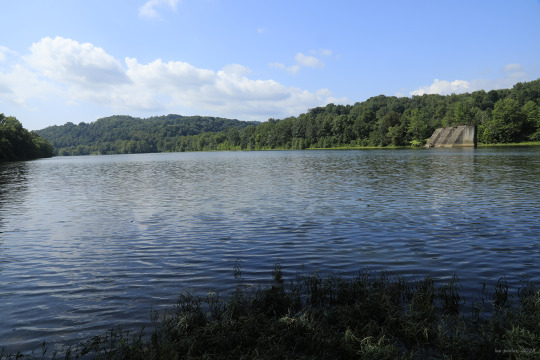
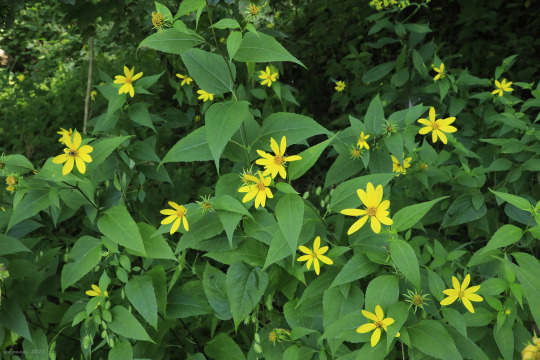


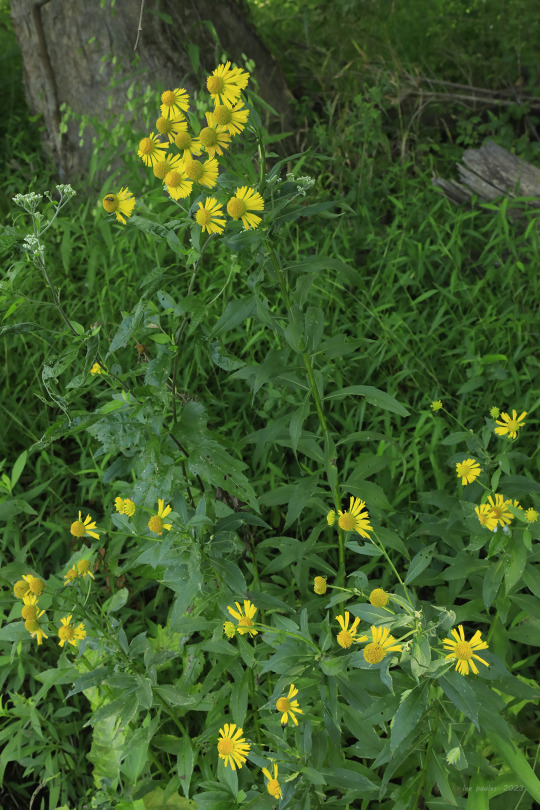

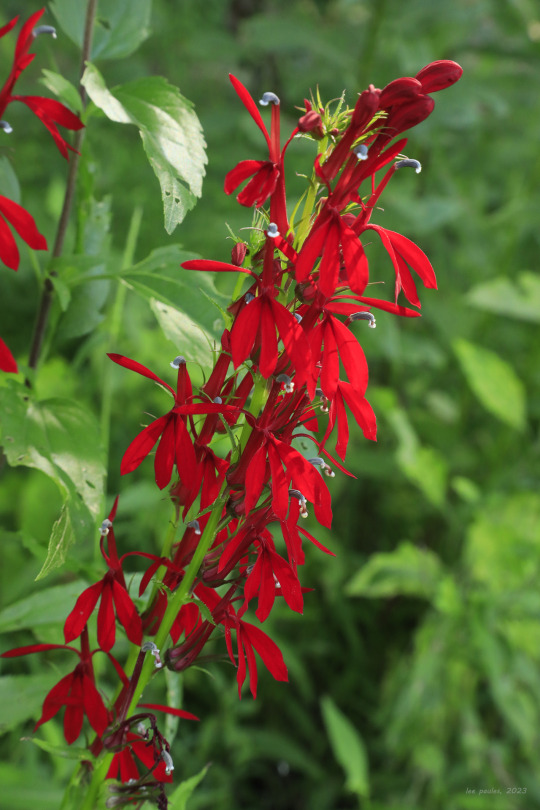



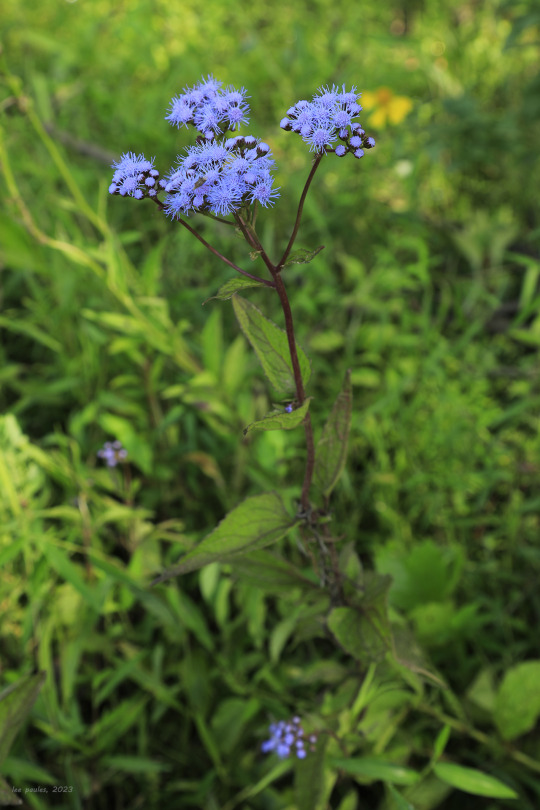
A selection of late summer wildflowers growing in the riparian zone along the Monongahela River at the Friendship Hill National Historic Site.
From top: Paleleaf woodland sunflower (Helianthus strumosus), also known as pale-leaved sunflower, distinguished by long leaf petioles and a pale leaf underside; common sneezeweed (Helenium autumnale), a water-loving aster whose dried leaves were once used to make snuff; cardinal flower (Lobelia cardinalis), whose scarlet, five-lobed flowers draw hummingbirds as pollinators; the closely-related great blue lobelia (Lobelia siphilitica), which early settlers once used as a treatment for syphilis (wishful thinking); and blue mistflower (Conoclinium coelestinum), or wild ageratum, a native aster that has become popular as a garden plant.

As a note, about a dozen sunflowers call NC-WV - SW PA home and they readily hybridize, often complicating identification. Pale-leaved sunflower has a tall, branching structure up to 7 feet in height and dense clusters of large flowers. In addition to long petioles and a pale leaf underside, this sunflower has a smooth stem with a whitish bloom to it. It's a very beautiful mid-to-late summer aster and one of my favorite wildflowers of Central Appalachia.
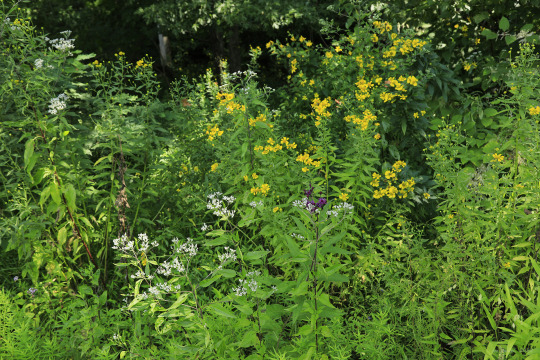
#appalachia#vandalia#wildflowers#flora#summer#pennsylvania#monongahela river#friendship hill national historic site#pale-leaved sunflower#paleleaf woodland sunflower#paleleaf sunflower#common sneezeweed#cardinal flower#great blue lobelia#blue mistflower#mistflower#wild argeratum#riparian
131 notes
·
View notes
Text
Embracing My Scotlander Identity: A Journey of Heritage and Experience
As a Scotlander—a term used to describe someone from Scotland or of Scottish descent—I have had the privilege of immersing myself in the rich tapestry of Scottish culture, history, and tradition for over four years. This journey has been more than just a geographical experience; it has been a deep dive into my own heritage and a celebration of the uniqueness that comes with being a Scot.

From the moment I stepped foot on the enchanting Scottish soil, I was captivated by the breathtaking landscapes that seemed straight out of a painting. The rolling hills, mist-covered mountains, and serene lochs all spoke of a land steeped in natural beauty and mystery. But beyond the scenic landscapes, it was the people that truly brought Scotland to life. The warmth and camaraderie of fellow Scotlanders welcomed me with open arms, making me feel like a part of a close-knit community.
Exploring the historical sites that dot the country was like stepping back in time. From the ancient walls of Edinburgh Castle to the haunting expanse of Culloden Moor, each site held stories of valor, struggle, and resilience. As a Scotlander, these stories became my own, weaving themselves into the fabric of my identity. The deep respect for history that Scots exhibit is infectious and has enriched my own perspective on heritage and legacy.
Of course, no discussion of Scotland would be complete without a mention of its vibrant cultural traditions. The stirring sound of bagpipes, the energetic rhythms of ceilidh dances, and the unmistakable taste of haggis are all emblematic of a culture that values its roots while embracing modernity. As a Scotlander, I've had the privilege of partaking in these traditions, not as a spectator, but as an active participant in the ongoing narrative of Scottish heritage.
Beyond the stereotypes, being a Scotlander has shown me the heart of a resilient and progressive nation. From its world-renowned universities and innovative industries to its emphasis on social equality and environmental sustainability, Scotland stands as a testament to the power of a small nation with a big heart.
In these past four years, I've not only lived in Scotland, but I've lived Scotland. My identity as a Scotlander isn't just about geography; it's about embracing a heritage that spans generations and continents. It's about cherishing the memories made amidst breathtaking landscapes, forging friendships, and carrying forward the torch of tradition.
As a Scotlander, I've come to realize that my journey isn't just one of experience; it's a journey of self-discovery and appreciation for the remarkable country that has become my home away from home.
1 note
·
View note
Photo

Beautifullll Frederick Douglass
“Douglass was born into slavery in February 1818, in Maryland as Frederick Augustus Washington Bailey. His mother, Betsy Bailey, delivered Frederick in her mother’s plantation cabin. Shortly thereafter, Betsy returned to the plantation where she worked, leaving Frederick with his grandmother. After only being able to see him a few times since giving birth, Betsy died when he was eight. At age 10, he was removed from his grandmother’s care and sent to live with another family; eventually, he would land on the plantation of Hugh Auld. Auld’s wife, Sophia, taught Douglass his alphabet and from that little bit of knowledge, he taught himself to read and write. Not long thereafter, Douglass was teaching other enslaved people how to read. Douglass would later say, "knowledge is the pathway from slavery to freedom.” When word got around that this former student turned instructor was teaching others to read, he was sold to a man known for being incredibly cruel to his “property.” After several attempts, Douglass was able to escape with some assistance of friends and a free African American named Anna Murray. In 1838, he traveled by train to New York to the safe house of abolitionist David Ruggles.
Once he arrived in New York, he sent for Anna, who he married. Unable to marry without the consent of his legal owner, he changed his name from Bailey to Frederick Johnson to avoid being discovered. Both he and his wife changed later their last name again to Douglass, after a character from the epic narrative poem The Lady of the Lake. The couple relocated to Massachusetts.
It didn’t take long before he became a leader of the abolitionist movement in Massachusetts and New York, gaining acclaim for his oratory and incisive antislavery writings. In fact, northerners of the time found it difficult to believe that Douglass had once been a slave. He was described by abolitionists as a living counter-example to slaveholders' arguments that slaves lacked the intellectual capacity to function as independent American citizens. He began his abolitionist work using his oratory skills to tell of his experience. His most famous work was Narrative of the Life of Frederick Douglass, an American Slave.
More than 50 years before the famous Plessy v. Ferguson case, in1841, Douglass and a friend were thrown off an Eastern Railroad train because Douglass refused to sit in the segregated railroad coach. He would join other abolitionists and they would travel throughout the Eastern and Midwestern United States speaking out against slavery and discrimination. There were occasions when he would be attacked by mobs as he spoke—the most brutal attack was in Indiana.
When he traveled to Ireland and England in 1845, he said he felt relieved of American racial discrimination. He wrote in his autobiography:
Eleven days and a half gone and I have crossed three thousand miles of the perilous deep. Instead of a democratic government, I am under a monarchical government. Instead of the bright, blue sky of America, I am covered with the soft, grey fog of the Emerald Isle [Ireland]. I breathe, and lo! the chattel [slave] becomes a man. I gaze around in vain for one who will question my equal humanity, claim me as his slave, or offer me an insult. I employ a cab—I am seated beside white people—I reach the hotel—I enter the same door—I am shown into the same parlour—I dine at the same table—and no one is offended ... I find myself regarded and treated at every turn with the kindness and deference paid to white people. When I go to church, I am met by no upturned nose and scornful lip to tell me, 'We don't allow niggers in here!’
Douglass remained abroad for two years. So admired by his British friends, they purchased his freedom from his owner, allowing him to return to the United States as a free man. Upon his return, he published his first abolitionist paper—The North Star. Its motto was: "Right is of no Sex – Truth is of no Color – God is the Father of us all, and we are all brethren." His paper was also funded by the British. While Douglass had been an admirer and a good friend of the great abolitionist William Lloyd Garrison, their long friendship ended because The North Star was in competition with Garrison’s abolitionist paper, National Anti-Slavery Standard.
Douglass also came to consider Garrison too radical. Earlier Douglass had agreed with Garrison’s position that the Constitution was pro-slavery because of its compromises related to apportionment of Congressional seats based on partial counting of slave populations. However, Douglass came to believe that the Constitution could and should be used as an instrument in the fight against slavery.
While splitting with Garrison, he joined with the women’s movement. Douglass was the only African American to attend the Seneca Falls Convention, the first women’s rights convention. It was at this convention that Elizabeth Cady Stanton called for the assembly to pass a resolution for women’s suffrage. While many in attendance were opposed, Douglass spoke in its favor. He said he could not accept the right to vote as a black man if women could not also claim that right. He went on to say,
“In this denial of the right to participate in government, not merely the degradation of woman and the perpetuation of a great injustice happens, but the maiming and repudiation of one-half of the moral and intellectual power of the government of the world.”
After Douglass spoke these powerful words, the resolution was passed.
In 1851, the North Star was merged with Gerrit Smith’s Liberty Party paper to form Fredrick Douglass’ Paper, which was published until 1860.
Douglass’ interests and attention evolved. He began to focus on education. He, like other abolitionists of that time, believed that education was key for African Americans to improve their lives. He became an early advocate for school desegregation.
Over the years, he would confer with and advise presidents—Abraham Lincoln on the treatment of black soldiers and Andrew Johnson on the subject of black suffrage. He was later appointed by Benjamin Harrison to serve as the United States’ minister resident and consul-general to the Republic of Haiti and charge’ d’affaires for Santa Domingo in 1889. He resigned in 1891.
Douglass and his wife, Anna, had five children. In 1877, the family moved to Washington, DC and bought their final family home. He and Anna named it Cedar Hill. It is now preserved as the Frederick Douglass National Historic Site.
Anna died in 1882. He was devastated by the death of his wife of 44 years. After a period of mourning, his life began to take on meaning from working with activist Ida B. Wells-Barnett. In 1884, Douglass married his secretary, Helen Pitts. Both his children and her parents were opposed to the marriage because Helen was Caucasian. In spite of their opposition, they remained married for 11 years.
Douglass died on February 1895, the month in which he was born and the same month that would later be celebrated as Black History Month.
In addition to the several versions of his autobiography, Douglass published: The Heroic Slave, My Bondage and My Freedom, Life and Times of Frederick Douglass. Among the notable speeches he delivered and that were later published are “The Church and Prejudice,” “The Hypocrisy of American Slavery” and “What to the Slave is the Fourth of July?”” (source)
Please order one of his books here!
61 notes
·
View notes
Photo

This was a fun yet spooky hike. #friendshiphill #nationalpark #hiking #getoutside #vanlife #travel #solotravel (at Friendship Hill National Historic Site) https://www.instagram.com/p/CTa8eojLMV4/?utm_medium=tumblr
1 note
·
View note
Text
Trailblazing Hollywood Architect Paul R. Williams, Part Two
Read Trailblazing Hollywood Architect Paul R. Williams, Part One.
Paul R. Williams’s Early Commercial Works
By the 1930s, Paul R. Williams’s architectural career had taken off, he was hiring more staff for his firm, and he had built an impressive portfolio of private residences, yet like all architects, Williams yearned for important commercial contracts (3). In 1926, he had collaborated with Norman Marsh to build the Second Baptist Church in Los Angeles, that would later become an important site to the civil rights movement in that area (7). One of Williams’s first solo commercial commissions was designing the interiors for the Beverly Hills Saks Fifth Avenue department store in 1938 (6). The following year he built the headquarters of Music Corporation of America (MCA) also in Beverly Hills (8). The clients hired Williams for their project because they envisioned their offices to look more like an English Georgian Revival style home than a typical office building of the time (3). He also designed the Arrowhead Springs Hotel in 1940. In 1941 Williams took on an international commission designing the Hotel Nutibara in Columbia (8).
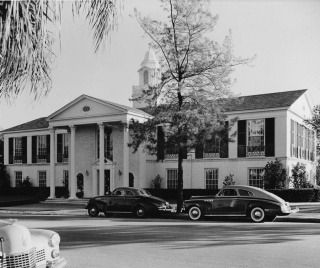
Paul R. Williams, Music Corporation of America Building (1938), Los Angeles, CA. Photo credit: Maynard L. Parker. Image source.
During World War II Williams closed his architectural office in order to take on work for the military. “In 1942 Williams designs 125 housing units for the Army at Fort Huachuca,” 8 and over the following years he worked with the Allied Architects on the Roosevelt Naval Base Project. Also during the war years, like European architect Jean Prouvé, Williams became interested in providing low-cost pre-fabricated metal housing. Williams established the Standard Demountable Homes Company of California in the mid-forties. The firm built mainly “Quonset-style homes [which] quickly fell out of favor after the war” 8.
Williams’s Post-war Buildings of the Mid-Century
After the World War II Williams teamed up with architect A. Quincy Jones, who had worked in Williams’s office in the years before the war. The two architects worked on several “projects in Palm Springs, including the Palm Springs Tennis Club (1947) and the Town & Country (1948) and Romanoff's on the Rocks (1948) restaurants” (6).
Williams’s most notable post war works include, the West View Hospital (1947), his 1949 additions to the Beverly Hills Hotel, the Al Jolson Memorial (1951), renovations to the Knickerbocker Hotel in Los Angeles (1954), the Frank Sinatra House (1955), and the Founder’s Church of Religious Science (1960).
During the 1950s Williams began a lifelong friendship with the popular comedian Danny Thomas when Thomas commissioned Williams to work on renovations to his existing home. When Thomas shared his vision of a children’s hospital open to all children regardless of race or religion that would offer free care, Williams was whole-heartedly on board. He designed the hospital gratis as an act of love for his dear friend (3). Saint Jude’s Children’s Research Hospital was built in Memphis, Tennessee in 1962, but was demolished in the early 1990s to make way for a larger more modern hospital (3).

Paul R. Williams, St. Jude’s Hospital Rendering (1961), Memphis, TN. Image source.
In 1960, Williams joined the Los Angeles Airport (LAX) planning and design team (1). He was not, however, the architect of the airport’s iconic Theme Building as many believe. It was designed by Gin Wong of Pereira & Luckman but [a] photo by Julius Shulman cemented the urban myth (5).
Paul R. Williams published two books on residential architecture: “The Small Home of Tomorrow (1945) and New Homes for Today (1946)” (5). He also wrote the essay "I am a Negro" first published in the 1937 and reprinted in Ebony in 1986 (5).

Architect Paul R. Williams in front of the LAX Theme Building in Los Angeles, CA. Williams is erroneously credited with the design of this building. He served on the LAX planning and design team, but did not design this structure. Photo by Julius Shulman. Image source.
Paul R. Williams’s Contributions to the African American Community
According to Paul R. Williams’s grandson Paul Hudson, Williams was instrumental in working on behalf of Los Angeles’s African-American community and in supporting its leaders and businesses. For his Golden State Life Insurance Building (1949) he commissioned two murals depicting the struggles of African Americans in United States history. A memorial to Williams was built in that building when it underwent a restoration in 2005 (3).
In 1946 along with Dr. H. Claude Hudson, Williams founded the Broadway Federal Bank. Its mission was to loan mortgages to African-Americans, and enabled many African-Americans to realize their dreams of home ownership. The bank also provided the financing on the 1960 Stall Case Study home designed by Pierre Koenig. Due to the house’s experimental nature, the owners could not obtain funding through traditional banks (3).
Williams’s Housing Project Work
Although Williams is best known for his mansions for movie stars and film moguls, he did design low-cost housing. Williams worked with another African-American architect Hilyard Robinson on the first federally funded public housing project in the Unites States Langston Terrace, Washington, D.C. in 1938 and later on the Pueblo del Rio project (1941) in southeast Los Angeles. Williams also designed, Carver Park, a segregated development in Henderson, Nevada. It opened in 1943. “Many of the units were destroyed between 1994 and 1999” (5). Williams was the Chief Architect on the The Hacienda Village Housing Project, other architect who collaborated on the project were Adrian Wilson, Richard J. Neutra, Walter Wurdeman and Welton Becket (5).
Paul R. William’s Endangered Legacy
In 1973 after a five-decade long career Paul R. Williams closed his firm and, he retired (6). He spent his final years devoted to his family and to causes supporting the African-American community. He died on January 23, 1980; his friend Danny Thomas gave the eulogy at Williams’ funeral (3).
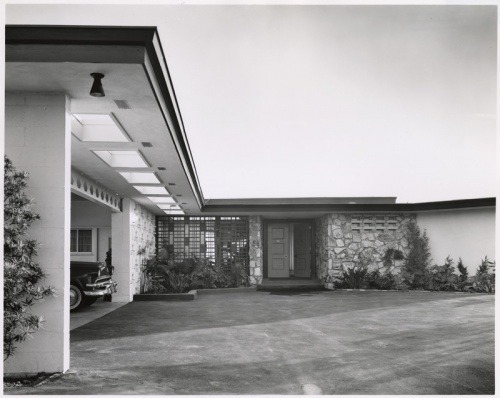
Paul R. Williams, Frank Sinatra House (1956), Los Angeles, CA. Destroyed. Image source.
Williams received many tributes and awards for his work during his lifetime among them, “the AIA Award of Merit, the NAACP Spingarn Medal, and USC’s Distinguished Alumni Award. In 1957, he became first African American to become an AIA Fellow (1). He was “posthumously awarded the AIA's 2017 Gold Medal, America's highest honor for an architect. Williams is the first African American to receive the AIA Gold Medal” (1). In 2020 a documentary about his life and work aired on PBS (3).
Tragically all of Williams’s business documents were destroyed in 1992 in a fire at the Broadway Federal Bank in the riots that took place in Los Angeles in the aftermath of the verdict in the Rodney King trial. Luckily, Williams’s blueprints and drawings had been saved by his granddaughter Karen E. Hudson who had borrowed them from the bank to do research on her grandfather’s career (3).
While several of Williams’s buildings have been placed on the National Register of Historic Places (6), an astonishing number of important buildings have not survived; notable among them are the Ambassador Hotel (1), the Frank Sinatra House, Perino’s Restaurant, the Sunset Plaza Apartments (3), the Claude A. Wayne House (1926), The George S. Seward House (1928), E. L. Cord House, aka Cordhaven (1932), The Lucy and Desi Arnaz Ranch (1941), The Tevis and Colleen Morrow House (1948) (5), La Concha Motel (1961) in Las Vegas, Nevada.
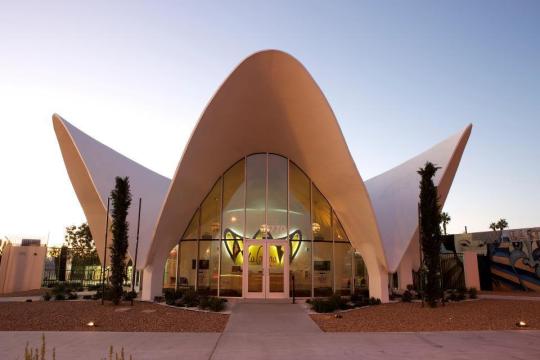
Paul R. Williams, La Concha Motel (1961), Las Vegas, NV. Destroyed. Image source.
References
LA Conservancy, (2020). Paul Revere Williams, FAIA (1894-1980), https://www.laconservancy.org/architects/paul-r-williams
Budds, D., (13 December, 2016). The Overlooked Legacy Of Pioneering African-American Architect Paul Revere Williams, Fast Company (online), https://www.fastcompany.com/3066503/the-overlooked-legacy-of-pioneering-african-american-architect-paul-revere-williams
Public Broadcasting System, (6 February, 2020). Hollywood’s Architect [Documentary Film]. https://www.pbs.org/video/hollywoods-architect-3prwsa/
Brane, K.D, (15 January, 2020). Paul R. Williams, Black Listed Culture, Issue 2. https://blacklistedculture.com/paul-r-williams/
US Modernist, (n.d.). Paul Revere Williams, FAIA (1894-1980), https://usmodernist.org/pwilliams.htm
Wikipedia.com, (10 December, 2020). Paul R. Williams, https://en.wikipedia.org/wiki/Paul_R._Williams
Wikipedia.com, (12 December, 2020). Second Baptist Church (Los Angeles). https://en.wikipedia.org/wiki/Second_Baptist_Church_(Los_Angeles)
Paul Revere Williams Project, (n.d.). Education | Timeline, https://www.paulrwilliamsproject.org/education/timeline
For Further Reading
Hudson, Karen E. (1993). Paul R. Williams, Architect: A Legacy of Style. New York: Rizzoli. p. 240. ISBN 0-8478-1763-6. LCC NA737.W527 H84 1993
Hudson, Karen E. (1994). The Will and the Way: Paul R. Williams, Architect. New York: Rizzoli. pp. 64. ISBN 0-8478-1780-6. LCC NA737.W527 H85 1994
6 notes
·
View notes
Text
The Ikelers: A Family Chronicle, 1753-2018 (Part III)
The Ikelers in the Nineteenth Century
There are many descendants of Wilhelm who, to this day, live within a few miles of Jerseytown and his original Greenwood farm. They are, most of them, eight or nine generations removed either from his eldest son, Andrew, or his only daughter, Elizabeth. (Barnabus, his second son, did not marry, and William, his third born, though he married in New Jersey and lived out his life in Columbia County, could not convince most of his descendants to stay. Many migrated west to Ohio and beyond.)
Especially if you can trace your ancestry back to Andrew Ikeler, you will easily find third, fourth and fifth cousins in Bloomsburg and neighboring townships. Evidence of their long presence and influence is everywhere in Columbia County—in two Ikeler cemeteries, a church, a street, and even a village named Ikelertown. In the case of Wilhelm’s friend Daniel, and his son-in-law William, Elizabeth’s legacy lives on in the ubiquity of the Welliver name in local phone directories, in the Jerseytown cemetery established by Daniel, and in numerous published histories of Daniel’s involvement with the ill-fated Whitmayers. There is, in fact, near Bloomsburg a country crossroads and a hamlet surrounding it named “Welliverville.”
Those two families, after all, were among the first pioneer farmers to clear and work the land after the 1780 treaty with the local native-Americans. Ikelers and Wellivers have been there ever since.
In this segment of the narrative, I’ll be looking at three generations of Ikelers who lived all or most of their lives in nineteenth-century Columbia County, PA. They are, in order, Andrew Ikeler (1772-1850) and his wife Christiana, nee Johnson (1774-1865); Andrew’s son Isaac (1804-1883) and his wife Mary, nee Taylor (1810-1872); and Isaac’s son Elijah (1838-1898) and his wife Helena, nee Armstrong (1840-1913). For information about the siblings of Isaac or Elijah (there were in fact a dozen), the best local sources are the County Courthouse and the Columbia County Historical and Genealogical Society in Bloomsburg. Under discussion here are only the children from whom my immediate family and I are descended.
Andrew reached his majority in New Jersey under the sole care of his mother. In 1792, he married the daughter of an English settler—the first with the new surname Ikeler to do so. Christiana Johnson’s father, Isaac, was most likely sympathetic to the British cause, since he allowed the union of his daughter to the son of a notorious loyalist. He also later moved to the Pennsylvania neighborhood where Wilhelm had settled. It appears that Christiana and Andrew may have been the last of their generation of Ikelers to leave New Jersey for Columbia County. The 1888 Beers Book makes reference to Andrew’s journey there in 1804. Presumably, he was waiting for confirmation from his father that the land they needed for their growing family had been purchased. That news came in 1804, and Andrew appears on the tax records of 1805 as the owner of a log cabin and a saw mill and 150 acres of land in Greenwood Township.
Unlike most of the farmers around him, Andrew seems to have cut quite a public figure. Near the end of the War of 1812, he led a company of militia to the defense of the nation’s capital. While underway, they learned the threat had passed, so he and his men returned to Columbia County without firing a shot. Again, in 1835, he made news when elected Magistrate at the ripe age of 62. At his death in 1850 he had outlived his brothers and his sister by nearly a decade.
We know precious little about Christiana’s life, either in New Jersey or Pennsylvania, but she and Andrew lived long enough to see many of their grandchildren grown, long enough to celebrate their 57th wedding anniversary, and, in her case, long enough to see the end of the Civil War. Born before the nation itself, she died at 91 in 1865. One can only image what a diary of her times she might have written!
She and Andrew are buried in the far right corner of what is known as the “churchless” Ikeler cemetery, at the top of a hill overlooking both their and Wilhelm’s original homesteads, and planted in corn to the very borders of the graveyard. The site functioned up until 1840 as the informal burial place for Ikelers and their near neighbors. In that year, Andrew’s eldest son, William, set money aside to preserve it in perpetuity and later erected the limestone tombstone that marks his parents’ last resting place. In the row immediately behind them are several broken slabs of slant, the inscriptions on them (if any) long since effaced. It is very likely that they mark the burial place of Wilhelm and his wife, presumably carried there (in 1808 and 1815 respectively) from their nearby log house in a homemade pine box, or perhaps simple in winding sheet.
Ironically, far less is known of Andrew’s son Isaac, my great-great grandfather, and his wife Mary Taylor. Though he followed his father’s example and married a woman of English stock, he kept close to the land Andrew left him, and rarely participated in the life of the wider community. Yet, since he lived into the 1880s, I suspect at least one photograph of him must have been taken, and may somewhere still exist. Certainly there are available photos of other children of Andrew.
Much research remains to be done on his wife as well. Happily, some has recently come to light through the efforts of my third cousin, Chris Sanders. Mary Taylor was sold by her father into indentured service at age twelve, along with her brother. The promise of an apprenticeship was often written into the contract—in Mary’s case, the promise was, in the course of her seven years of servitude, that she would be taught “the mysteries of housewiffery.” Why her father, a widower, was driven to take such an extreme measure remains a mystery. Perhaps he simply thought he couldn’t manage their upbringing on his own. It was, as one wise genealogist reminded me, a different time.
Mary’s servitude did, at least, have a foreseeable end. She married Isaac Ikeler immediately upon regaining her freedom at 19, in 1829. Her son Elijah, perhaps as a tribute to the suffering she had endured in her adolescence, christened his second son with the middle name “Taylor” just two years before his mother’s death. Her memory was apparently cherished by later descendants as well---they passed it down to this very day as the middle name of at least four other Ikeler males. Mary, fortunately, was something of a genealogist herself, and faithfully kept what she knew of the Ikeler family tree on the flyleaf of her bible. For most of us, that partial record represented the starting point for our research into the early generations.
Mary Taylor Ikeler predeceased her husband by eleven years. Isaac passed away in 1883. All but one of their eight children survived into adulthood. Both parents are buried under well-preserved limestone monuments in what became the next, newer Ikeler cemetery, atop Ikeler Hill and directly across the road from the Ikeler Church. Their resting place sits right above the border between Mt. Pleasant and Greenwood Townships, looking down on the very hills and fields they plowed.
Elijah Redmond Ikeler, their fourth child and second son, is perhaps the most widely remembered and controversial of all the Ikelers in this history. Even his birth year is debatable, variously recorded as any of four years between 1837 and 1840. Most sources, including his large granite tombstone in Bloomsburg’s Rosemount Cemetery, declare it to be 1838, however.
From his early days he appears to have been disinclined to take up farming. At 18 he was apprenticed to a mill owner, and shortly thereafter had acquired a share in the business. At the outset of the Civil War, he seems to have been equally disinclined to take up arms in defense of the Union. Whether he paid the standard $300 to send someone else in his place, or simply wasn’t called up because the local quota of soldiers had already been filled, he clearly had no interest in risking his young life for a cause he didn’t believe in. In a Bloomsburg newspaper article from 1864, in which a local volunteer at the front complains about the lack of support and enthusiasm from the folks back home, Elijah is quoted (among others) arguing in favor of a compromise with the Confederacy that would allow the Southern States to keep their slaves and end the bloodshed sooner.
By that time he had already been married for a year—to one Helena Armstrong, two years his junior and a resident of Bloomsburg. Her father owned a prosperous stonemasonry business, producing monuments in limestone and granite for local cemeteries and public places, as well as the marble window frames and sills for the more prepossessing homes along Main and Market Streets. Helena also brought an impressive pedigree to the union with Elijah: among her father’s ancestors were the socially prominent Rittenhouses of Philadelphia, and the Hiesters, one of whom had been an officer under Washington in the Revolutionary War. She was thus a member of the D.A.R., with the bona fides to prove it. On her mother’s side she was descended from the Vanderslices, a Dutch family and one of the wealthiest in Columbia County.
How did Elijah, the 25-year-old son of a Greenwood farmer, manage to marry into an established upper middle class family such as the Armstrongs? Probably a combination of ambition, political savvy, and good looks. He looks out from photographs and portraits taken of him then and later with a self-assurance and a symmetry of aspect that commands admiration.
By 1865, he and Helena had taken up residence in Bloomsburg, the county seat, at the time a settlement of some 3,000 souls on the banks of the Susquehanna. Elijah would remain a townsman the rest of his life. He struck up a friendship with a much older Bloomsburg lawyer, John Freeze, who had lost his own sons to childhood illnesses several years before. Freeze took him under his wing, taught him the law, and, from 1867, admitted him into his own practice as a fellow attorney. Thereafter, Elijah rose quickly to political prominence, becoming Bloomsburg town treasurer in 1870 and district attorney a short time later.
His domestic fortunes, despite an initial setback, were also advancing. In 1867, Helena had lost a pair of twins, but she gave birth to one healthy son, Frank Armstrong Ikeler, the next year, and another robust boy, Fred Taylor Ikeler, in 1870. Why they had no more children after that, though both were in their early thirties, I can only speculate.
Certainly Elijah grew increasingly involved with public affairs and the business of making money. He participated in the early prosecution of the Molly Maguires (though the miners were ultimately tried, convicted and hanged by others), and he bought numbers of residential properties within Bloomsburg proper (whether for rental income or resale I haven’t been able to ascertain). By the 1880s he thought himself well enough known and respected to run for elected office. The position he sought was that of Presiding (or President) Judge: a five-year term of office with jurisdiction over both Columbia and two adjoining counties. He was twice elected: in 1888 and again in 1893. He ran again in 1898 at the age of 60, but fell ill in the midst of the campaign and died within a week in August, 1898. At the time of his death he was living on Market Street in a mansion-sized home of his own design, known for years after as “the Judge’s house.” The building has since been extensively renovated and functions today not as a place of residence, but as a funeral home.
In the last two decades of his life, there was also much going on at home to keep him happy with only two children. Given his risen position in society, Elijah was clearly ambitious for his sons. They both attended and graduated from Lafayette College—the first Ikelers to earn baccalaureate degrees—and, by the mid-90s, both boys had begun to practice law, just as their father had done.
Aside from vague rumors that Elijah was a bit too fond of the bottle, and his arguable lack of patriotism during the Civil War (neither one of which sins was considered much of a problem in that part of Pennsylvania), everything about his life and his family seemed above reproach. Particularly in 1888, when he ran for high office, it was essential to his success: he needed to present an unblemished record to the voters of three counties.
One small problem arose the year before that election. A chronicle of Columbia County was being prepared, a chronicle that would rely for much of its information on interviews with prominent members of long-established families in the region—people who could recount their own and their ancestors’ history. The chronicle (known then and since as “The Beers Book”) was due to be published in 1888, shortly before Elijah planned to open his election campaign. And, given his social prominence, there was certainly no Ikeler more likely to be approached for genealogical information than Elijah. All to the good, it would seem: a chance to boast, modestly of course, of his and his forefathers’ accomplishments, and perhaps, amongst interested readers, to gain a few votes.
The Ikeler section of the Beers Book that appeared in 1888 does indeed suggest the interviewee was Elijah—more than half of the entry praises the deeds of the would-be Presiding Judge, and has little to say of his siblings or his parents.
But the passage makes some quite curious claims about earlier generations. Fact gets oddly mixed up with fiction—the first Ikeler [it reads] was “Joseph Eggler...of an honored old family of German extraction,” not a tenant farmer named Hieronymus Eichler; he landed in New Jersey, not Philadelphia, arriving in 1760, not 1753; most curious of all, “at the outbreak of the Revolution he promptly enlisted with the Colonists, and throughout that historic conflict unselfishly rendered service to his country.” This founding father of the American Ikelers is also said to be Elijah’s great-grandfather, when in fact Hieronymus is his great-great-grandfather. Elijah skips a generation in order to make Andrew, not Wilhelm, the son of this fictional hero. It is Andrew, so the account runs, who brought the Ikelers from New Jersey to Greenwood Township in 1804.
What Elijah’s version does, of course, is to wipe out the first seven years of the family’s indentured servitude, credit Hieronymus/Joseph with an honorable, unselfish war record on the side of the Colonists, and eliminate Wilhelm and the “shame” of his fugitive years altogether. There simply is no Wilhelm in Elijah’s account of his ancestry.
It’s a neat blending of fact and fiction, calculated to sit well with his neighbors and the electorate. But I suspect Elijah’s dissembling had a second, and perhaps more powerful motivation behind it. He was, we remember, married to a member of the D.A.R., a descendant of a genuine hero on the side of the Revolution. When the chronicler came calling, Elijah could enhance respect for his heritage in the eyes of Helena by “recalling” an equivalent hero in the Ikeler family past. But it was even more important for both husband and wife that he expunge any trace of Wilhelm and the family’s loyalist background. And God forbid, Helena should find out one of her husband’s ancestors was a redcoat under arms during the conflict!
Elijah’s efforts to bowdlerize or mythologize his family’s past remained unchallenged for another 27 years, until both he and Helena were no longer among the living. At last, in 1915, and just two years before his own death, I suspect it was I.B. Ikeler who offered a very different story to the county historian who came by collecting information for a second edition of the chronicle: “In another account it is stated that William Ikeler [so the 1915 printed version reads] was the name of the founder of the Columbia county branch of the Ikelers. William Ikeler also came from New Jersey and settled on a farm…approximately one hundred twenty-five years ago [i.e., circa 1790]. His wife’s name was Barnhart, and their issue were four children: Andrew, William, Elizabeth and Barnabus.” Except for getting Elizabeth Bengert’s maiden name wrong, his version squares with the facts as we now know them. I.B. Ikeler was in the best position to set things straight, after all, since it was he who held that “ancient” deed of sale, the proof that William Ikeler had paid 450 hundred pieces of gold or silver for an additional 350 acres of land in 1804.
1 note
·
View note
Text
Courtyard | © Courtesy of AMAN
Embracing the Nakhi culture and the breathtaking mountain views, the Amandayan Resort lies on the hillside just above the UNESCO-protected Old Town of Lijiang. Architect and Aman design veteran, Edward Tuttle, sought inspiration from the traditional architectural styles of the local people.
Amandayan Resort Technical Information
Architects: Edward Tuttle
Location: Lijiang, China
Material: Wood, Stone
Topics: Unesco Heritage, Renovation, Resort, Spa
Area: 1.6 hectares (4 acres)
Project Year: 2015
Photographs: © Courtesy of AMAN
Lijiang is known for its unique Nakhi architecture and is a treasure trove of history and culture.
Amandayan Resort Photographs
Rooftops | © Courtesy of AMAN
In between Spaces | © Courtesy of AMAN
Wood Facade | © Courtesy of AMAN
Guest Room | © Courtesy of AMAN
Balcony | © Courtesy of AMAN
Lobby | © Courtesy of AMAN
Dining Room | © Courtesy of AMAN
Portico | © Courtesy of AMAN
Spa | © Courtesy of AMAN
© Courtesy AMAN
The property draws its name from the Sanskrit-derived word for ‘peace’ and Dayan, the historical name for Lijiang when the ruling Mu family first established it in the 13th century. Lijiang is known for its unique Nakhi architecture and is a treasure trove of history and culture. The Old Town is a UNESCO World Heritage Site and is as famous for its intricate system of canals as for the traditional embroidery of its artisans.
Set atop Lion Hill above the winding lanes and canals, Amandayan is a serene retreat with panoramic views. The fabled city merges into a patchwork of fields that lap against snow-capped peaks on the horizon.
Featuring detailed Nakhi embroidery and carved wooden screens, Amandayan’s 35 suites open onto tranquil courtyards and offer consummate privacy in exquisite surroundings. Graceful and elegant with clean, simple lines, the suites are contemporary in style yet still unmistakably Chinese, decorated with materials and fabrics from the region. For the interiors, designer Jaya Ibrahim employed intricate wood carvings, embroidered Nakhi textiles, and furnishings crafted from local pine and elm. The spacious balconies, in particular, make the most of its dramatic setting of snow-capped mountains, mirror-flat lake, green fields, and pine forests.
Lijiang’s UNESCO World Heritage Site also incorporates Baisha and Shuhe, two historic villages. Shuhe is known for its cobblers, while Baisha was the former capital of the Nakhi and has changed very little over the centuries. Baoshan Stone Village is another picturesque site nearby, where houses and even furniture were traditionally made of stone.
For the interiors, designer Jaya Ibrahim employed intricate wood carvings, embroidered Nakhi textiles, and furnishings crafted from local pine and elm.
The Resort also offers a Tea House, where visitors can savor delicate dim sum and traditional Chinese tea.
There is also an in-house museum opposite the traditional Tea House, developed in collaboration with National Geographic. The museum houses information, photographs, and original artifacts relating to the famed Austrian-American Botanist Joseph Rock, who made Lijiang his home for several years before the 1949 Communist revolution.
An Aman Spa overlooks a heated outdoor swimming pool, informed by traditional Chinese medicine. Four treatment rooms are equipped with a steam shower and a peaceful relaxation area, and two additional wet treatment suites host scrubs, baths, and wraps. The spa is also home to a fully equipped gym and a Pilates studio.
The consistently graceful and clean design is typical of Aman: contemporary and luxurious yet unarguably a deeply considered product of its environment.
Amandayan Resort Image Gallery
#gallery-0-4 { margin: auto; } #gallery-0-4 .gallery-item { float: left; margin-top: 10px; text-align: center; width: 20%; } #gallery-0-4 img { border: 2px solid #cfcfcf; } #gallery-0-4 .gallery-caption { margin-left: 0; } /* see gallery_shortcode() in wp-includes/media.php */
© Courtesy AMAN
© Courtesy AMAN
© Courtesy AMAN
© Courtesy AMAN
© Courtesy AMAN
© Courtesy AMAN
© Courtesy AMAN
© Courtesy AMAN
© Courtesy AMAN
© Courtesy AMAN
© Courtesy AMAN
© Courtesy AMAN
© Courtesy AMAN
© Courtesy AMAN
© Courtesy AMAN
© Courtesy AMAN
© Courtesy AMAN
© Courtesy AMAN
© Courtesy AMAN
© Courtesy AMAN
© Courtesy AMAN
© Courtesy AMAN
© Courtesy AMAN
© Courtesy AMAN
© Courtesy AMAN
© Courtesy AMAN
© Courtesy AMAN
© Courtesy AMAN
© Courtesy AMAN
© Courtesy AMAN
© Courtesy AMAN
© Courtesy AMAN
© Courtesy AMAN
© Courtesy AMAN
© Courtesy AMAN
© Courtesy AMAN
© Courtesy AMAN
© Courtesy AMAN
© Courtesy AMAN
© Courtesy AMAN
© Courtesy AMAN
© Courtesy AMAN
© Courtesy AMAN
© Courtesy AMAN
© Courtesy AMAN
© Courtesy AMAN
© Courtesy AMAN
© Courtesy AMAN
© Courtesy AMAN
© Courtesy AMAN
© Courtesy AMAN
About Edward Tuttle
After gaining much of his early design experience in Asia – where he spent seven years working on hotel projects across the region – Tuttle set up his firm, Design Realization, in 1977. Based in Paris, the studio undertakes the entire aesthetic of its projects, overseeing the architecture, interior architecture, and furniture design.
Its portfolio comprises residential and Resort projects, including several properties for Park Hyatt and many for Aman, where Tuttle developed a close friendship with founder Adrian Zecha. Along with Kerry Hill, John Heah, and Jean-Michel Gathy, he is credited with setting a new standard in resort design.
One of his most notable projects – Amanpuri in Phuket, Thailand – opened in 1988 and marked the beginning of a new chapter in hospitality design, paving the way for contemporary destination hotels. Tuttle was also renowned for reflecting the cultural flavor and feel of the places in which his projects were built and would strive to use local materials and techniques right to the architecture of each location.
Other works from Edward Tuttle
[cite]
Amandayan Resort in Lijiang, China / Ed Tuttle #hospitality #edtuttle #resort #chinesearchitecture Embracing the Nakhi culture and the breathtaking mountain views, the Amandayan Resort lies on the hillside just above the UNESCO-protected Old Town of Lijiang.
1 note
·
View note
Text
Velaris National Park
Fics Masterlist
Chapter 1
Green light filtered through the canopy, patches of gold peppering the road ahead. Rolled down windows allowed the late spring air weave through the car, carrying the scent of growing things and warmth to wrap around us.
Elain had some 2000s pop station pouring from the speakers, all of us belting out the familiar words to our audience of Mother Nature. Nesta had called shotgun at the beginning, leaving me to have the back seat to stretch out, propping my feet on the bag that held our borrowed tent.
It was May in Prythian, warm and good and green. I had just graduated from my master’s program in Art History, my whole future stretching out ahead of me. Elain had insisted we celebrate but all of us were in educational debt and couldn’t afford to fly anywhere. Ever the florist, she found a state park a few hours away that boasted the largest collection of wildflowers in the country, one especially that bloomed once every three years. And because Elain was always lucky, this year was one of the few that it blooms in full.
A few days after graduation, she managed to wrangle Nesta away from the publishing house and me away from my couch and stuffed us all into her 2005 Honda.
Velaris National Park
Turn off 5 miles
Elain’s singing broke off mid-verse, a squeal replacing the lyrics as she pointed out the sign. I could only smile at her excitement; camping was never really our family’s thing, but her happiness was too infectious. At least I had managed to throw my sketchbook and watercolor pencils into my bag before she dragged me out the door. It had been a while since I had done some wildlife sketching, there was not a lot of green space or biodiversity in the city.
She turned down the music while Nesta and I straightened in our seats, ready to hop out of the car and get blood flowing back into our legs.
Even Nesta who normally tolerated Elain’s antics had a ghost of a smile playing around her lips, the fresh air loosening her iron grip on her emotions.
Elain slowed the car, turning right before the massive stone wall that announced the entrance to the park, gravel crunching under the tires.
The rough road weaved with the terrain, up and down and curving around hills and patches of meadows that peaked through the trees. We even rumbled over a wooden bridge that spanned the banks of a sparkling stream, the water throwing shimmering rainbows into the air.
A low log cabin-like building greeted us, its small parking lot only holding a Jeep with the park logo on the side and another car.
Elain turned the car off and all of us popped our doors open, slightly stumbling as our legs reacclimated to moving. Small groans slipped out of our mouths as we stretched feeling back into our lower halves, taking in the new environment.
A small sign in the window informed us of the park’s office hours and the emergency phone line. Elain pushed in first, a petite ding announcing our arrival.
The inside was a simple, square room, half the room stocked with souvenirs and anything campers may need in a pinch. A long, low counter ran along the back wall with an open doorway hinting at the back room. This was where a perky blonde emerged, greeting them with a bright smile. Her long hair was braided down her back, a forest green polo stamped with the logo somehow accented her curves instead of looking dorky and too stiff.
“Hi! Welcome to Velaris National Park. I’m Mor, what can I help y’all with today?”
“Hello! I’m Elain and these are my sisters Nesta and Feyre,” she gestured to each of us in turn, we all shook her hand, surprised to find it calloused and strong.
“How long do y’all plan on staying?”
“Two nights, please. And if you can point out on a map where the Starfall flower will be blooming?”
Mor laughed, a grin splitting her mouth. “I should’ve guessed, this is some of our busiest weeks of the year. Well, you’re in luck, we have only a few campsites left. Any preference to where?”
“None at all, we’re not too picky.”
“Perfect, how about y’all take site 20. It’s near the trailheads and not too far from the bathrooms.”
Elain turned to confirm with us, we each nodded back. Our lack of experience had us indifferent to where we camped, as long as it wasn’t out in the middle of nowhere.
Elain and Mor exchanged money and maps, paying for our spot and pointing out the major landmarks of the park.
“We do allow fires, as long as they’re in the designated fire pits. Please use the trash cans we have all along the park, anyone caught littering can be fined up to 200 dollars along with not being allowed to revisit the park. No glass or alcohol on park grounds. If y’all need anything, please don’t hesitate to call up to here the main office, and the numbers for our rangers are on the maps, along with the emergency line. Further into the park, cell service can get a little spotty, but as long as you stay near the trails, our rangers can spot you if you get into trouble. A little tip, don’t feed the wildlife, we have them on a diet,” she finished with a laugh and a wink. We laughed along with her, it was easy to feel a friendship forming with the bright woman.
“Well if that’s all y’all need, just keep following the road and you’ll see the signs pointing out the campsite. Parking gets a bit limited so try not to double park.”
We thanked her and headed out to pile back into the car.
As we were pulling out and getting back onto the road, I spotted one of the rangers on top of a horse.
The animal was tall, taller than any of the horses I had ever encountered before, and blacker than the deepest night sky. Its rider was sitting perfectly still, used to having to blend into the background.
I stifled a gasp. The ranger was the most beautiful man I had ever seen. I was too far away to see the color of his eyes, but they peeked through the leaves, boring into mine. His shoulders were broad, covered with a khaki shirt, he gripped the horse with powerful legs clad in dark green pants that were tucked into wore brown boots.
Our car soon turned a corner, breaking my gaze from his, banishing me of the spell he had cast.
More gorgeous forest passed us by, feeding my artist's mind with texture and light and color. Maybe this trip would replenish my weary mind after years of rigorous study. I loved every minute of my classes, but it left little free time for drawing and painting.
Wooden signs ticked up, eventually indicating where our sight was. Once again parking, we exited the car and took in the scenery.
We were to share a small common area with a few other campers, picnic tables and grills dotting the grassy area. Two cars were already parked there, brightly colored tents peeking out from the bushes that gave each sight a bit of privacy. Under a massive oak tree, there was a ring of rocks that held gray and black ashes from prior fires, stumps surrounding it for us to sit and enjoy the company.
I grabbed the tent from the backseat and slung my pack over my shoulder, leading the way to the small clearing that would be our home for the next few days. It was simply packed dirt, slightly raised from the rest of the ground so that if it rained, our tent would not get flooded.
I had never set up a tent before but with the instructions from the bag combined with the store owners’ tips, it was soon popped up in no time. Maybe only slightly leaning to the left but that would be a problem for later.
Nesta had pulled out our coolers of food, prepping sandwiches for a late lunch. Elain was already off in the surrounding area, making notes of the greenery and wildflowers that grew nearby. It was not the elusive Starfall but it did not take much for her to get wrapped up in flora.
Satisfied at my work, I tossed our bags into the tent and zipped it up. We could unpack after a bit of exploring.
Joining Nesta at the table, I swiped one of the completed sandwiches, ignoring her protest to wait for Elain. She was the one who refused to stop for lunch so she would just have to get the next one.
My fingers itched to start drawing the massive oak tree, its complex branches and multicolored leaves begging to be noticed and put onto paper. My stomach, however, told me it can wait.
Nesta somehow pulled Elain away from a blue flower, convincing her that it won’t disappear in the next 15 minutes.
“So, what’s first on the agenda, sis?” I asked her.
“Well it is getting a little late so I don’t want to go too far before it gets dark, but I thought we could start with one of the short trails!” Elain radiated energy, feeding off the teeming forest around us.
I smiled back at her, excited to start cataloging the world around us. We finished off the sandwiches and repacked the coolers into the car. One thing we all learned from watching TV was to not let wild animals get into a camper’s stash of food.
A quick trip into the tent had us changed into t-shirts, shorts and tennis shoes with light jackets tied to our waists. Even with Prythian warming up, the nights could still get a bit cool.
Elain consulted the map Mor gave us, confidently leading us to the first trailhead. It was only two miles long and would introduce us to the wildlife we could see in the park.
Every few hundred feet, plastic signs would pop up, listing fun facts about the park and giving an example of some of its inhabitants. Some would show a burst of color followed by the flower’s common name, scientific name and any medicinal or historical facts about it. Others would tell you how to spot an animal camouflaged in the surrounding foliage.
We all talked and joked with each other, with no tension that usually accompanied us when we got together. Nesta told us a story about an author that tried to sneak in her friends’ manuscript that turned out to be an awful rendition of Twilight and Fifty Shades of Grey. By the end, all of us were in stitches and barely able to walk, clinging onto tree trunks and each other in an attempt to stay upright.
Just as the sky was glowing orange and pink, the trail delivered us back to the beginning of the campsites, all we had to do was follow the gravel road back to ours.
The smell of meat and potatoes set our stomachs growling, the sandwiches from earlier long gone from the hike and laughter.
The other campers that were out earlier had returned.
“Howdy!” one of the men shouted at us waving his arm. He looked to be in his late fifties with combed back salt and pepper hair, sporting cargo pants and a navy long sleeve to ward off any wayward cool breezes.
We all gave back nervous smiles, unsure of who our neighbors were.
“Kevin,” a voice scolded, “you can’t just yell at unsuspecting young girls.” The source of the admonishment appeared from the bushes.
“Sorry about my husband, he’s just excited to have more company,” a man apologized. He also looked to be in his fifties, a bit shorter than Mike but leaner. Dark brown skin was covered in matching cargo pants, but a faded Prythian U sweatshirt covered his torso.
“I’m Raymond, this is our third night at the park.”
We tried not to look too relieved as we shook his hand. All of us had experience taking care of ourselves but we were in the middle of a national park with the other nearest humans about 50 yards down the road.
Kevin looked appropriately sheepish as he came to greet us. “Sorry about that, I am excited to have more company. The couple that’s over there just keeps glaring at us and avoids us like the plague.” His words were playful enough but there was a deeper sadness buried in his eyes as if he was used to this sort of treatment.
“Well it’s awesome to meet you,” Elain gushed, ever the social butterfly. “I’m Elain and these are my sisters, Nesta and Feyre. We’re here in celebration of Feyre graduating!”
“Congratulations! Where from?” Raymond asked.
“Well you’re actually wearing my college right now,” I replied with a smile. There were tons of people who went to Pryth U but it was always fun to meet someone who graduated there in the past.
I fell into conversation with Ray, who insisted on using the shorter version of his name about the campus and how much it has changed from when he was there. He was an engineering major but still asked me a million questions about the art history department and why I wanted to get my masters there. Elain roped Kevin into a debate about botany and the best soil for growing tulips in. It sounded like he was also in the flower business and was here to see the blooming of Starfalls.
Nesta was never one to make easy friends and opted to start our dinner, taking over the grill next to Kevin’s. Tonight was burgers with potato chips and then s’mores for dessert that would be roasted over the campfire.
Dinner was full of lively conversation under the night sky. We were far enough away from the city’s light pollution that we were able to make out constellations that we had only read about and see the dusting of galaxies that spanned the sky.
“And that’s when the professor realized he had designed a system that looked exactly like a dick!” We burst out laughing at the end of Ray’s story from his time in college, even Nesta couldn’t keep her giggles contained at the raunchy tale.
Our cheeks were rosy from the fire that crackled happily before us, the smell of burnt marshmallow filling the air. As perfect as Nesta was at everything, it took her a few tries to get the timing and distance right for roasting.
“Sounds like I missed a hell of a tale,” the new midnight voice sent shivers down my spine.
“Ah! Rhys! I was wondering when you would show up,” Kevin greeted the newcomer. “Where are Cas and Az?”
The figure stepped into the ring of light and perched on an open stump beside Feyre. I forced myself not to freeze and stare at him. It was the same man I saw on top of the horse.
Closer up I could see how his dark hair shone blue in the firelight, no longer hidden beneath the Mountie hat he wore earlier.
He shifted his body to angle slightly towards me, catching my eyes with his. They were so blue they seemed to be an impossible violet, sparking with hidden laughter at an inside joke. “They’re right behind me,” he said without breaking eye contact with me.
I forced my eyes to drop to the page I was intermittently sketching on. I was lucky that I had started a new outline of the stream we passed on the way in instead of still having the sketch of him on his horse open. Hopefully the blush that was already on my cheeks hid the new blood that was rushing there.
“What was all that laughing about? I hope someone was making fun of Rhys,” another male voice called out as he came into view. He was tall and even more well-muscled than the man beside me but had his dark hair pulled into a low bun on the nape of his neck and his eyes glowed amber.
Rhys broke his stare at me to twist to the man, “No, I was telling them about the time you got stuck in what you thought was quicksand but turned out to be just a massive mud pit,” he shot back. The group laughed at the retort, including me while trying to shake off my embarrassment.
He pouted at the memory, “Aw com’on, you promised you would stop bringing that up.”
“Never in your dreams, brother.”
“Cas, come sit by me and have a s’more, I’m sure you thought you were right at the time,” Kevin teased, offering a marshmallow already speared on a stick. Cas threw one more sulky look at Rhys and walked over to where Kevin and Nesta were sitting. Nesta sized up the addition, bracing herself for interaction.
Cas saw her reaction, immediately forgetting his brother’s teasing. There was a new opponent to spare with. He aimed a feral grin at her, spurring her to narrow her eyes at his assessment.
A final figure, presumably Az, emerged from the dark, almost as if melting from it. He nodded a polite greeting to the group opting to stand near Ray and Elain. It took no time at all for her sister to draw him into a conversation about what all she can see at the park and if she was allowed to take any wildflower clippings home to preserve.
I turned back to my book, darkening the path the water took over, around and through the stones on the creek bed. The weight of Rhys’s gaze settled over me, making me tighten my grip on the pencil.
“You’re a good artist,” he remarked.
I smiled slightly in his direction. “I would hope so, I staked most of my career on it.”
“You do this professionally?”
“Well, I hope so someday,” I admitted, “I just graduated with a master’s in art history.”
“Really? Congrats. What’s next for you?”
He finally succeeded in pulling me away from the drawing, meeting his gaze again, looking for any sign of mockery at my chosen path. Most heard the words “art history” and assumed I would become a starving artist or elementary art school teacher.
There was no trace of judgment in his face, only open curiosity.
“In my dreams, I would open up my own studio, maybe a few galleries. For now, I’ve applied to a few museums as a curator and I have an interview with one of them next week.”
“I hope it goes well, anyone who can draw that well must know a thing or two about Picasso.”
I barked a laugh at his statement, “I can’t even begin to tell you how wrong you are,” giggling my way through the sentence. “You won’t believe the number of students I met who couldn’t tell the difference between Picasso and their own ass.”
His eyes flashed with surprise, followed by laughter rich and clear as a bell spilling from his mouth. “I can believe it, I’ve met my fair share of idiots in this world.”
“I bet, being a park ranger must set you up for a whole slew of idiots who watched one episode of Bear Grylls and thinks they can survive out here with nothing more than their wits.”
His face jokingly darkened, “Do. Not. Get. Me. Started.”
“Please, start,” my sketch was now long forgotten, pulled into his expressive voice and body. He wove the tale of a couple that thought they could go all Naked and Afraid only 20 feet off the trail, managing to get as far as cutting down a few trees to start a shelter before another camper contacted them and they were able to stop them from scarring any more people.
My cheeks hurt from the constant smiling and laughter, unable to stop myself from leaning closer to catch every detail.
By the end of his story, our knees were brushing each other every few seconds, both of us catching our breath. He paused at the end, taking the small bubble we had trapped ourselves in.
His eyes dipped to brush my lips before meeting mine again. My breath caught in my throat at the intensity of his gaze, heat blooming across my cheeks and down my neck. Our shared air was sweet with chocolate and heavy with anticipation…
A hiss startled us apart.
Across the fire, Nesta looked to be about two seconds away from slapping Cas, fury twisting her face into a knot. Cas looked like he was the cat that got the cream, lazily reclining against the stump, looking up into her wrathful face.
“And that’s our queue,” Rhys muttered under his breath. “It was wonderful to talk with you. I’ll see you around the park.”
I blinked a few times, mentally shaking myself out of the trance he put me in. “Uh, yeah sure, see you around.”
“Cas, Az,” his voice was sharp, “We need to go to the next campsite. Thank you for the s’mores and have a good evening everyone.” He pulled his brothers away, retreating into the dark. From the blackness came the sound of a sharp slap and angry words being whispered.
Everyone exchanged awkward looks at their departure. Nesta was still fuming, glaring at the direction they disappeared in. Feyre and Elain knew better that the question her on what Cas said, knowing it would only infuriate her more.
“It’s been a long day, and we have a lot of hiking tomorrow,” I broke through the tension, “I’m off to bed.” Elain and Nesta got up to join me, bidding Kevin and Raymond good night and that they’ll see them for breakfast.
Elain and I exchanged worried looks behind Nesta’s back, but it would be better to let her sleep it off. She was quick to anger but given time, could squash it back down.
We all climbed into the tent, leaving our shoes by the door. It was colder away from the fire, so we didn’t waste time layering on warmer clothes and crawling into our respective sleeping bags.
I fell asleep with purple eyes burning behind my eyelids, chasing me through my fitful dreams.
Next Chapter
#acotar#acomaf#acowar#acofas#sjm#sjmaas#sjm books#sjmaas books#feyre#feyre x rhysand#rhysand#cassian#azriel#morrigan#amren
1 note
·
View note
Text
U.S. Intelligence Agency Memorandum: KCIA used the Unification Church since 1961

INVESTIGATION OF KOREAN-AMERICAN RELATIONS HEARINGS before the SUBCOMMITTEE ON INTERNATIONAL ORGANIZATIONS of the
COMMITTEE ON INTERNATIONAL RELATIONS HOUSE OF REPRESENTATIVES
NINETY-FIFTH CONGRESS, SECOND SESSION
SUPPLEMENT TO PART 4
MARCH 15, 16, 21, AND 22, 1978
___________________________________________
COMMITTEE ON INTERNATIONAL RELATIONS
CLEMENT J. ZABLOCKI, Wisconsin, Chairman
___________________________________________
Investigation of Korean-American Relations by the Subcommittee on International Organizations
DONALD M. FRASER, Minnesota, Chairman
MICHAEL HARRINGTON, Massachusetts
EDWARD J. DERWINSKI, Illinois
BENJAMIN S. ROSENTHAL, New York
WILLIAM F. GOODLING, Pennsylvania
LEE H. HAMILTON, Indiana
LEO J. RYAN, California
Robert B. Boettcher, Subcommittee Staff Director
___________________________________________
Part 4—Documents Relating to Korean Cultural and Freedom Foundation, Inc., and Radio of Free Asia
CONTENTS
A. Summaries of representative documents contained in sections B through J
page 1
B. FBI investigative report dated 1964-66, entitled “Dr. Seymour Murray Vinocour; William A. Curtin, Jr.; Kim Tong Song—RA Korea”
page 28
C. File of Admiral Arleigh Burke (Ret.), founding president, Korean Cultural and Freedom Foundation, Inc
page 209
D. Declassified documents provided by U.S. intelligence agencies
page 457
E. Declassified documents provided by the Department of State
page 475
F. Declassified documents provided by the U.S. Information Agency
page 510
G. Correspondence among the Department of State, the Department of Justice, and the Federal Bureau of Investigation, with respect to an investigation of Radio of Free Asia, 1971-72
page 531
H. Minutes of meetings of the Board of Directors of the Korean Cultural and Freedom Foundation, Inc
page 617
I. Auditors’ workpapers regarding Korean Cultural and Freedom Foundation, Inc., Arthur Young & Co. and Price Waterhouse
page 671
J. Miscellaneous documents
page 706
Note:—Deletions in the attached documents are for the purpose of security or the protection of an individual’s privacy
___________________________________________
ABBREVIATIONS
APACL Asian Peoples’ Anti-Communist League
APACL-FC Asian Peoples’ Anti-Communist League Freedom Center
Burke Memo Memorandum for the Record prepared by Adm. Arleigh Burke
Burke # Document provided by Adm. Burke; number assigned by him
FARA Foreign Agents Registration Act (18 U.S.C. 951)
FBI Report FBI Investigative Report dated 1964-66, entitled “Dr. Seymour Murray Vinocour; William A. Curtin, Jr.; Kim Tong Son -- RA Korea”
ISD Internal Security Division, Department of Justice
KBS Korean Broadcasting Service
KCIA Korean Central Intelligence Agency
KCFF Korean Cultural and Freedom Foundation, Inc.
ROFA Radio of Free Asia
ROK Republic of Korea
ROKG Government of the Republic of Korea
UC The Holy Spirit Association for the Unification of World Christianity; commonly known as The Unification Church
___________________________________________
NOTES
Not all documents attached are included in the summaries of Section A.
Known variations of Korean names are given the first time the name appears. Individuals are identified the first time their names appear.
___________________________________________
A. SUMMARIES OF REPRESENTATIVE DOCUMENTS CONTAINED IN SECTIONS B THROUGH J
1. 1961: FBI Report, Interview of Vinocour
In 1961, Vinocour (Seymour Murray Vinocour, also known as Joseph Vinocour), PR consultant to the Korean Embassy in Washington, was contacted by Ambassador Chung II Kwon (then-Ambassador to the U.S. later Prime Minister; currently Speaker of the National Assembly) who advised him of the ROKG’s interest in establishing APACL-FC. Chung arranged an ROKG-sponsored trip to Korea to enable Vinocour to confer with authorities of APACL-FC. Vinocour also discussed the project with Kim Jong Pil (Kim Chong Pil, founder of the KCIA; then-Chairman of the ruling Democratic Republican Party). As a result of these discussions Vinocour submitted a prospectus for U.S. fundraising for APACL-FC, a copy of which was given to the ROK Embassy in Washington, D.C. The trip never took place because Vinocour terminated his formal association with the ROKG in September 1961.
2. Spring 1962: Day of Hope in Review, Part 1, 1972-74, p. 173
The Reverend Sun Myung Moon is said to have founded the Korean dance troupe known as the Little Angels which were organized in the spring of 1962.
3. February 26, 1963: CIA Information Report
Kim Jong Pil organized the UC while he was the director of the KCIA, to be used as a political tool. The church was headed by the Reverend Moon, founder of the Olive Tree Cult. [Reverend Moon founded the Unification Church. Elder Tae-seon Park founded the Olive Tree Cult.]
4. Early 1963: FBI Report, Interview of Vinocour
APACL-FC Preparatory Commission, Korean Chapter, publishes a proposal for the establishment of a Freedom Center to be built and staffed for anti-communist activities in Korea. This was decided in June of 1962. They have the full concurrence of the ROKG, including financial support. An ROKG Cabinet meeting of August 17, 1962 granted 50 acres of land for the construction of the center. The site is identified as Jang Choon-Dan Park on Namsan Hill in the southeastern section of Seoul City.
5. Early 1963: Burke #69, Historical background of APACL-FC
Includes a financial statement indicating that the ROKG has contributed $538,461.
6. Summer 1963: FBI Report
Cho Dong Ha (also known as Dongha Cho), a representative of APACL-FC and the ROKG, and said to be close to President Park Chung Hee, contacts Vinocour about raising funds in the U.S. for the construction of the FC.
7. Fall 1965: Burke Memo
Former ROKG Ambassador Yang You Chan (also known as Chan Yang) approaches Burke with the idea of establishing a tax-exempt foundation to promote mutual understanding, respect and friendship between the U.S. and Korea. Yang urges Burke to become Founding Chairman. Burke is reluctant but Yang succeeds in persuading him. Burke will become Chairman and Yang will be responsible for overseeing the day-to-day operations, establishing a Board of Directors, and appointing an Executive Director with a staff.
8. Fall 1963: FBI Report, Interview of Luis Corea
Yang approaches Corea of Riggs National Bank for his support of an organization proposing to build a structure in Seoul memorializing U.S.-Korean friendship and to serve as a cultural center.
A preliminary meeting was held, attended by: Admiral Arleigh Burke (Ret.), who accepted the presidency; Colonel William A. Curtin, Jr. (Ret.); Ambassador Yang; Colonel Pak Bo Hi (also known as Bo Hi Pak; then-military attache in the Korean Embassy in Washington); and Luis Corea.
The proposed organization is to be known as KCFF.
9. November 5, 1963: FBI Report, Interview of Vinocour
Vinocour sends his feasibility study for fundraising for APACL-FC to Cho Dong Ha.
10. December 1963–January 1964: Burke Memo
Yang and Burke have several meetings regarding plans for KCFF projects and personnel.
11. December 21, 1963: Burke #1, Brochure of KCFF
Yang sends a copy of KCFF’s brochure to Burke. The Little Angels is the only proposed project.
12. Early 1964: Burke Memo
Burke says that Yang appointed Curtin. Burke does not know Curtin but trusts Yang’s judgment. Yang told Burke that Col. Pak Bo Hi had greatly assisted him in the preliminary work on KCFF and is keenly interested in the Foundation. Burke says that he only knew Pak from social functions at the Embassy; he describes him as suave, a good administrator and a hard worker. Burke says that he is heavily committed in other areas and relies on Yang, Pak and Curtin.
13. Early 1964: Testimony of Robert Roland before the Subcommittee on International Organizations, Activities of the Korean Central Intelligence Agency in the United States, June 22, 1976, p. 14
Roland, one-time member of the KCFF Board and a social acquaintance of Pak, is told in early 1964 by Pak of his plans to form KCFF to gain influence and raise money for the Reverend Moon. At the same time Pak also speaks of forming ROFA.
14. January 10, 1964: Burke #5, Letter from Yang to Dr. Decker
Yang congratulates Clarence L. Decker, Academic Vice President of Fairleigh Dickinson University, on Decker’s trip to the ROK as a guest of the ROKG to attend President Park’s inauguration. Yang inquires about a conversation between Kim Jong Pil and Dr. Decker in which Kim is said to have discussed KCFF and pledged his full support to the Foundation.
15. January 17, 1964: Burke #8, Letter from Curtin to Kim Jong Pil, Chairman, Democratic Republican Party
Curtin says that he has been informed that Kim has been briefed on KCFF and has indicated his approval and support; also, that Kim has accepted the position of Honorary Chairman of the Board.
16. January 21, 1964: Burke #6, Letter from Decker to Yang
Decker confirms his conversation with Kim Jong Pil in which they discussed the Foundation.
17. ca. January 21, 1964: Burke #13, Biographical Sketch of Kim Jong Pil
Because Burke does not know who Kim Jong Pil is, Pak Bo Hi provides him with a biographical sketch.
18. January 26, 1964: Burke #9, Letter from Kim Jong Pil to Curtin
Kim says that he has been thoroughly briefed on all aspects of KCFF; he gives his endorsement and accepts the position of honorary chairman.
19. February 23, 1964: Burke #61, Letter from Curtin to Kim Jong Pil
Curtin suggests that it appears to be appropriate and politically judicious for the ROKG to award a governmental decoration to Pearl Buck for The Living Reed. A Washington ceremony would accord international press coverage.
20. March 12, 1964: Burke #62, Letter to Curtin from Kwan Soo Park, Chairman, APACL-FC
Park informs Curtin that Kim Sang In (also known as Steve Kim; an aide and interpreter to Kim Jong Pil; later an employee of KCIA) has forwarded Curtin’s proposal for the “Freedom Center Fund Raising Program.” He asks for a more formal proposal and contractual conditions.
21. March 18, 1964: Burke #22, Letter from Curtin to Park Kwan Soo, Chairman, APACL-FC
Curtin outlines the program which KCFF has suggested for raising of U.S. funds for the Freedom Center. He asks APACL-FC to provide certain information, including total contributions of ROKG and total donations. He requests Park Kwan Soo to forward an enclosed copy of this letter to Kim Sang In.
22. ca. March 18, 1964: Burke Memo
Burke is concerned about KCFF’s involvement with APACL-FC. He discusses these reservations with Yang and Curtin. He is particularly concerned about supporting an organization over which they have no control. Also, KCFF is not in a position to make any significant financial commitments. Burke is under the impression that Yang and Curtin agree.
23. March 24, 1964: FBI Report, Letter to Vinocour from Cho Dong Ha
Kim Dong Sung (former Vice Speaker of the National Assembly) will be appointed adviser to the ROKG Ambassador to the UN in place of Col. Ben Limb (also known as Im Byung Jik). When Kim’s appointment is announced, a formal request will be made for him to be in charge of APACL-FC fundraising in the U.S. Kim Jong Pil, President Park and Prime Minister Choi are ready to advance the $10,000 requested in Vinocour’s proposal. Kim Dong Sung wants Cho to come to the U.S. with him. Cho asks Vinocour if he can be put on Vinocour’s payroll when the contract is awarded.
24. March 27, 1964: FBI Report, Interview of Corea
KCFF is formally incorporated in Washington, D.C., by William A. Curtin, Jr., William E. Carey and Luis F. Corea.
25. April 14, 1964: KCFF Minutes
The KCFF incorporators meet and name Burke, Yang, John G. Flowers and Lawrence W. Horning to the Board of Directors.
26. April 17, 1964: FBI Report, Letter from Cho Dong Ha to Vinocour
Cho relates the substance of a letter from William Curtin to Kim Jong Pil in which Curtin states that since Ambassador Kim is unwilling to undertake the APACL-FC project, and Vinocour’s proposal has been turned down, that KCFF can raise $500,000 for the project. Cho says he has contacted Curtin and asked for a proposal and contract. Curtin’s reply is that KCFF will raise funds at no cost to APACL, and thus no contract is necessary. Cho says Curtin has not yet received a commitment. Cho asks what Vinocour knows about Curtin. Cho says he is applying pressure to have Kim Dong Sung’s appointment at the UN announced so that Kim can come to the U.S.
When Kim comes, Cho will be with him.
27. May 1, 1964: FBI Report, Personal letter from Vinocour to Cho Dong Ha
Vinocour is annoyed about ROKG handling of the APACL-FC project and suggests that communications problems exist between the Embassy and Seoul. It has been almost one year since he submitted his proposal but he has not received an answer; KCFF now proposes to raise funds for APACL. Vinocour suggests that KCFF has plagiarized his original proposal.
28. May 22, 1964: Letter to Gene F. Caprio, Bureau of Intelligence and Research, Department of State; from Nathan B. Lenvin, Chief, Registration Section, Internal Security Division, Department of Justice
The subject is Joseph Vinocour, William Curtin, and Kim Tong-song; Foreign Agents Registration Act, Korean Activities in the United States. Reference is made to Caprio’s memorandum of April 29th in which he requested advice as to whether the subjects and/or KCFF are or ever have been registered under the FARA. Lenvin says that a review of Registration Section’s files reveals no registration for any of them, and that he is unable to determine if Joseph Vinocour is the same S. M. Vinocour who was registered until September 25, 1961 as an agent of the Korean Information Center. Lenvin is therefore requesting the FBI to ascertain this information as well as whether any of the individuals will be engaged in fundraising in the U.S. for APACL-FC.
29. May 25, 1964: Letter to Director, FBI, from J. Walter Yeagley, Assistant Attorney General, Internal Security Division
Yeagley requests the Director to have the FBI conduct an investigation to determine: whether Joseph Vinocour is the same as S.M. Vinocour; whether Vinocour will be raising funds in the U.S. for APACL-FC; whether Curtin has engaged in similar activities; and to determine the accuracy of the reports that Kim Dong Sung will be named ROK Consul General in New York and will be raising funds for APACL-FC in the U.S.
30. May 25, 1964: Burke #64, Letter from Curtin to Park Kwan Soo of APACL-FC
Curtin says KCFF’s application for certification as a non-profit organization is pending. The Treasury Department has taken exception to the program for support of APACL-FC because of the substantial out-flow of U.S. dollars. Burke and Yang will align sufficient political, Congressional and philanthropic strength to overcome these objections. Curtin says KCFF wants to support APACL-FC; that it will be among their prime objectives.
31. May - June 1964: FBI Report
Dong Sung Kim is to be named Korean Consul General in New York City, and is to raise funds for APACL-FC.
32. July 1, 1964: Burke #65, Letter from Park Kwan Soo to Curtin
Park Kwan Soo acknowledges receipt of Curtin’s May 25th letter and says that the Chosun Ilbo has reported that KCFF has included APACL-FC as one of its major projects. Park says that they have received a letter from Col. Pak of the Korean Embassy in Washington in which he informed them of the establishment of KCFF.
33. Summer 1964: FBI Report, Interview of Corea
Corea is visited by Pak Bo Hi at this time and urged by him to institute a workable fundraising campaign for KCFF.
34. September 1964: Burke Memo
Ambassador Yang informs Burke that Pak, who had been assisting Curtin, is very much interested in the work of KCFF. Yang says he hopes Pak will resign from the Korean Army and become an assistant to Curtin. Yang tells Burke that Pak’s prospects with KCFF are better than they would be back in Korea. Pak has impressed Burke favorably and therefore Burke is in favor of Pak’s continued association with KCFF.
35. September 4, 1964: Burke #37, Letter from Yang to General Min Ki Shik
Yang says that Pak provided the inspiration and guidance resulting in the establishment, development and current operational capabilities of KCFF. Pak could contribute far more to the attainment of ROKG objectives by associating himself with KCFF than by continuing his career as a Regular Army officer. Pak can interpret anti-communism in KCFF’s day-to-day operations and can achieve far more for the overall good of the ROK than by serving as an Army officer. Yang asks for Pak’s release from the Army so that he can take over as Vice President and Director of KCFF. Yang further states that KCFF intends to pay Pak a salary.
36. October 3, 1964: Burke #43, Letter from Pak to Curtin
Pak thanks Curtin for a luncheon prior to Pak’s departure and for Curtin’s seeing him off at the airport.
37. Fall 1964: FBI Report, Interview of Curtin
Pak approaches Curtin and tells him he is going to retire from the ROK Army and will be returning to the U.S. in early 1965. He wants to assist KCFF, particularly with the Little Angels project. Curtin accepts the offer.
38. November 3, 1964: Burke #46, Letter from Pak to Yang
Pak apologizes for not having reported earlier as they had planned. He says that he arrived in Seoul on October 7th and after two weeks began the processing for his discharge. Pak says that Yang’s letter to General Min was helpful because action was taken immediately and by October 22nd he was a civilian; Pak says this is viewed as “unprecedented.”
Pak says that in his 14 years of military service he had dedicated himself to the honorable service of his country and that in his position with KCFF he will dedicate himself to even greater service for his country.
Pak says he has already begun working for KCFF. He has delivered Yang’s letter to General Lee at the Blue House and made an appointment to give him a briefing on KCFF; met with Park Chong Kyu (head of the Presidential Protective Force) of the Blue House and Yang can count on him as a partner in their efforts. Park will try to arrange a meeting with President Park to brief him on the Foundation. Pak has also called on Prime Minister Chung II Kwon who agreed to be a member of the Advisory Council of KCFF. Pak has used the National Film Production facilities to produce a 30-minute color movie of the Little Angels. Pak says he will continue his all-out campaign to earn credit and understanding for Yang’s leadership in the Foundation.
39. November 3, 1964: Burke #47, Letter from Pak to Curtin
Pak tells Curtin about the Little Angels film and other promotional details of a proposed U.S. tour. Pak also tells Curtin, “Regarding your concern of so called ‘Mr. Kim Yong Tae’s letter’ (Kim Yong Tae is a close associate of Kim Jong Pil) you have nothing to worry about.” Pak says that “they” can’t hamper the development of the Foundation; he is there in Korea to take care of this. He says he will report in his next letter and asks for a report on developments on Curtin’s side, noting that he is most concerned with the fundraising aspects.
40. November 3, 1964: Burke #50, Letter to Burke from Pak
Pak informs Burke that he was honorably discharged from the Army on October 22nd, in order to join KCFF. On that same day he formally assumes the Vice Presidency of the Foundation.
41. November 6, 1964: Burke #49, Letter from Curtin to Pak
Curtin acknowledges receipt of Pak’s letter and says that he will comment on it and send an up-to-date report separately.
Curtin tells Pak that Garfield I. Kass, whom Pak knows, will be visiting Seoul in the near future. There are enclosed letters for Pak to have delivered to the Premier, the Vice Premier and the Foreign Minister. Curtin says there are copies for Pak and copies have been provided to Kass. Curtin suggests that Pak check with the U.S. Embassy on Kass’s itinerary. Curtin also suggests that Pak arrange a special performance of the Little Angels for Kass; he says he thinks it will “pay off.”
42. December 10, 1964: Burke #52, Letter to Yang from Pak
Pak gives run-down on Kass visit, detailing his itinerary. He says that Kass was well-satisfied and that they have earned another good friend for Korea. Pak had arranged for Kass to meet the following ROK officials: Mr. Park, special assistant to the President, National Assemblyman Kil, and Premier Chung.
43. December 18, 1964: U.S. Intelligence Agency Memorandum for the Record
Kim Jong Pil started the Tong-il (UC) Church about one year ago. The KCFF in Washington is the first step toward organizing a Tong-il in Washington. It has been previously reported that Bud Han (also known as Han Sang Kook/Keuk/Kuk), Pak Bo Hi and another Army officer were involved with the Washington organization; the third party is Kim Yong Ju or Kim Yong Chun. Yang You Chan is identified as a mere front-man, used to endow the organization with respectability. Pak Bo Hi is the real leader. Pak will return to Washington soon.
44. January 4, 1965: U.S. Intelligence Agency Memorandum for the Record
Kim Jong Pil has been using the Tong-il Church (UC) since 1961.
His interpreter (Steve Kim) is involved in this organization. The organization is secret and run like a communist organization. Bud Han is now General Min Ki Shik’s aide.
45. ca. March 1965: FBI Report, Interview of Curtin
Pak returns to Washington and starts working officially for KCFF.
He volunteers to assist KCFF financially and arranges through the ROK Embassy for the use of their addressograph plates for KCFF initial fundraising (30-40,000 names). These names are from the Korean Information Services mailing list. KCFF also will use Richard A. Viguerie Co., Inc.
46. March 5, 1965: FBI Report, Interview of Curtin
Current employees of KCFF: Curtin, Pak Bo Hi, Caesar A. Giolito. All serve without salary. Giolito was employed at Pak’s insistence.
Pak Bo Hi’s association with KCFF is through the Little Angels which KCFF hopes to bring to the U.S. on a nationwide tour. The time for this tour will be approximately May 1965, to coincide with President Park Chung Hee’s visit to the U.S. Pak Bo Hi is the Project Director for this tour.
Pak has told Curtin that he has contributed substantial personal funds to support the Little Angels. Pak also has a deep spiritual interest in the Unification Church, a Korean spiritualist group in the Washington area.
Curtin denies any direct or indirect contact with the ROK Embassy, nor does he have any understanding, agreement or contract with the ROKG. KCFF is an American-Oriental organization that hopes to be a vehicle of expression in U.S. foreign policy, particularly in Korea and Southeast Asia.
Curtin believes that he is exempt from having to register with the Justice Department as a foreign agent because KCFF is solely engaged in activities in furtherance of religious, scholastic, academic or scientific pursuits.
Curtin says that the APACL-FC as it appeared in the original draft of the KCFF brochure has been eliminated as a project of KCFF and will not receive any support from KCFF. The inclusion of the FC in the KCFF brochure goes back to 1963, when Curtin prepared the brochure, and was unaware of U.S. Treasury regulations governing the exporting of U.S. dollars.
47. Spring 1965: FBI Report, Interview of Vinocour
Park Kwan Soo, Chairman of APACL-FC, writes to Vinocour asking him to reconsider the FC project, (cf. May 15, 1965)
48. April 13, 1965: Burke #57, Letter from Earl Voss to Burke
Voss says, as he had told Burke when they met at Mickey Kim’s house (Mickey Kim, also known as Kim Un Yong, KCIA official at the ROK Embassy in Washington, later assistant to Park Chong Kyu), when they had discussed KCFF’s representations about fundraising for APACL-FC, that he is learning more about the Freedom Center. Leaders at the APACL-FC are upset that KCFF is representing in its brochures that the FC is its #1 project without the Center’s permission. They regard KCFF as “some sort of racket” using the FC’s name to raise funds.
49. April 26, 1965: Burke #60, Letter of solicitation from Burke to Fellow Americans
The letter contains a brochure setting forth KCFF’s current objectives. The objectives include activities in support of anticommunist organizations in the Far East, coordination with other anti-communist organizations in the U.S., and aiding and supporting the Freedom Center under the auspices of APACL.
50. April 28, 1965: Burke #66, Letter from Pak to Burke
Pak says he has been instructed by Yang to give Burke full information for a reply to the April 13, 1965 letter from Voss. Pak says that the APACL-FC people have misunderstood and he advises Burke to send a polite letter to the FC stating the current status of KCFF without mentioning Voss’s letter. He also suggests writing a letter to Kim Jong Pil, chairman of the ruling Democratic Republican Party, asking him to tell APACL-FC officials of KCFF’s earnest intentions and current situation.
51. May 25, 1965: KCFF Minutes
Pak is elected a member of the Board of Directors and Vice President of KCFF. Pak has arranged a U.S. tour for the Little Angels with KCFF as the official sponsor. Although sponsorship of the Little Angels had not been officially brought before the Board, KCFF directors vote to accept sponsorship since it appears to them to be a fait accompli.
52. May 1965: FBI Report, Interview of Vinocour
(date established by Vinocour’s use of word “recently”)
Pak Bo Hi calls on Vinocour. Vinocour formerly knew Pak as a military attache at the Korean Embassy. Pak now identifies himself as the project director or PR man for KCFF in its efforts to assist the APACL-FC. Pak tells Vinocour that Curtin is not doing the job and that KCFF is bankrupt.
53. May 26, 1965: Burke #70, Letter from Pak to Burke
Pak mentions Yang’s recent address before the Political Study Club being inserted in the Congressional Record of April 27, 1965.
54. May 27, 1965: Burke #71, Letter from Pak to Burke
Pak says that Dr. Chin Kim and Cho Dong Ha, officers of APACL-FC visiting Washington, met with him. They have ironed out their misunderstandings and differences. They had already met with Yang. Pak says that he made it clear that KCFF is still interested but not obligated. Because KCFF is in its formative stage, the APACL-FC should not depend on the efforts of KCFF.
55. June 1965: FBI Report, Interview with Don Kramer (date possibly earlier)
Cho Dong Ha requests that Kramer urge their mutual acquaintance Vinocour, a professional PR counselor, to undertake informal noncontractual agreement to work for APACL-FC.
Kramer talks to Vinocour and is advised that Cho has not been totally candid with him; Vinocour had previously submitted a professional program. Kramer says he reported Vinocour’s reaction to Cho.
Kramer’s impression was that Cho was trying to explore Kramer’s availability to assist, but that no direct overtures were ever made.
Kramer says that Cho is living with Tongsun Park at 1713 22nd Street, N.W., Washington, telephone 232-6860. Kramer’s impression is that Tongsun Park is subsidizing Cho during his stay but not contributing to the Freedom Center.
56. June 8, 1965: Burke #76, Letter from Cho Dong Ha to Burke
Cho asks Burke if KCFF would act as agent to collect and transmit contributions for APACL-FC.
57. June 8, 1965: Burke #77, Letter from Burke to Cho Dong Ha
Burke says that KCFF would be happy to act as a repository for U.S. donations to the APACL-FC. However, these contributions would be subject to 15% commission.
58. July 12, 1965: Burke #82, Letter from Robert W. Roland to Burke
Roland informs Burke that Pak has been an acquaintance of his for a number of years. He has discussed KCFF with Pak many times.
Pak has told him that KCFF is to function as the financial supporter and propagator of the ideology of the Unification Church, headed by Moon.
59. August 1965: Burke Memo
Burke advises Yang of Roland’s letter concerning Pak. Yang assures Burke that he is certain Pak is not misusing KCFF and that he, Yang, would not permit it. Yang adds that Pak is a devout Buddhist.
Burke comments that the matter could not be resolved without further data. There is no indication that the Foundation is being misused, but it has to be carefully watched. Burke contemplates resigning because he feels that things are happening of which he is not aware. He submits his resignation on August 6, 1965, to be effective in September or October.
60. August 26, 1965: Burke #99, Letter from David Rowe to Earl Voss
Rowe says that Yang is in Korea on a short visit, and that he is working on staking a claim for KCFF in relation to the APACL- FC. Yang has represented that KCFF can supply a backer, Mr. Salvatori, who is a very big potential source of money for the FC.
Yang told Rowe that before he had left for Korea he had had a meeting with Burke at which he proposed that Burke approach Congressional Members of the committee supervising the CIA to have them bring pressure on the CIA to put a large amount of money into the APACL-FC. The purpose would be to use the FC for recruiting and training agents, since students from all over Asia and Africa would be arriving there. All this was said in the presence of a secretary from the Foreign Office who had been assigned to Yang.
Rowe says that he is confident Burke will not fall for this idea but is unsure of other members of KCFF or Congress. He asks Voss to see Burke and show him this letter.
61. August 27, 1965
William A. Curtin, Jr. dies.
62. September 9, 1965: Burke #100, Letter from Burke to Voss
Burke disavows involvement in the Salvatori idea and says that he did not know that Yang and Dr. Haynes Fraser had had such an idea. Burke says that he had thought the CIA idea a bad one and had told Yang so before he left. Burke says the reason for his meeting with Yang was for Burke to submit his resignation. Burke asks Voss not to use this information to embarrass Yang.
63. September 13, 1965: KCFF Minutes
Burke, Corea and Carey exhibit concern about the financial status of the Foundation. A resolution is passed that: certified public accountants will be employed to certify financial statements and to make an annual report to be delivered to the president and the executive committee; that Pak Bo Hi will make monthly statements to the treasurer with copies to the executive committee, showing all income and expenditures; and that hereafter projects will not be initiated until funded. Funds raised for a specific purpose will be held in trust until full funding has been achieved.
64. December 1965: FBI Report, Interview of Vinocour
On December 14, 1965, Vinocour had lunch with Min Pyong Whi, the First Secretary of the ROK Embassy. Min stated that Cho Dong Ha does not represent the ROKG in his fundraising efforts in the U.S. for the APACL-FC. Min said that Cho had returned to Korea in November and would not return to the U.S. before February or March 1966. Min feels that duplicate organizations such as KCFF and the Freedom Center create confusion.
65. May 15, 1966: KCFF Minutes
First mention of the ROFA project is at this meeting. General Coulter, president and chairman, states for the record that Pak Bo Hi is one of the founders of the KCFF and that he had returned to the U.S. for the sole purpose of pioneering the projects of the Foundation. General Coulter gives the following information regarding Pak:
– Yang requested the ROKG to release Pak so that he could work for the Foundation.
– The ROKG granted the release. On July 3, 1965 (sic; KCFF minutes of May 25, 1965 indicate that it was at that meeting that Pak was elected director and vice president of KCFF) Pak returned to Washington and took up a fulltime position as vice president of KCFF.
– Pak has been working fulltime since that time in his capacity as vice president. Pak has not received any salary or compensation for his services for the entire year of 1965.
The Board votes to pay Pak $750 per month, retroactive to January 1, 1966.
66. July 14, 1966: KCFF Minutes
Corea and Carey resign from the Board, making a total of four vacancies. The vacancies are filled by: Tongsun Park, Lawrence L. Mays, Leigh Brite, and Leon Fontaine, all effective August 1, 1966. Kyong Eup Kim (also known as Jimmy Kim) is appointed Operations Director of the Foundation in Seoul. His duties will be to establish KCFF headquarters and make initial arrangements for the ROFA project.
Yang informs the Board that the ROKG Minister of Public Information had requested Kim’s appointment as Operations Director. The Board specifies that Kim is not to incur any expenses chargeable to KCFF until advised that funds are available.
Lawrence L. Mays is appointed International Chairman of ROFA.
67. August 9, 1966: KCFF Minutes
The stated purpose of the meeting is formally to institute ROFA as the principal project of KCFF and to formulate policy for ROFA. The Board sets August 15, 1966 as the date for the first broadcast from KBS transmitters. The Board authorizes a trip to Korea for Mays, Yang and Pak to negotiate a contract with the ROKG for the inauguration of ROFA.
68. August 10, 1966 U.S. Intelligence Agency Report
The Seventh Bureau (Psychological Warfare Bureau) of the KCIA has been given the task of working out a proposal for the reestablishment of ROFA. The operation is tightly held within the KCIA and is apparently the result of a KCIA-Washington letter to KCIA director Kim Hyung Wook, and communication from Kim to Yang You Chan. Director Kim, who is said to be enthusiastic about the project, and the 7th Bureau are expected to discuss the matter with Yang.
69. August 1966: Testimony of General Kim Hyung Wook, former director, KCIA, before the Subcommittee on International Organizations, Investigation of Korean-American Relations, Part 1, June 22, 1977, p. 28
Kim said he first met Pak in 1964; Pak was not connected with the KCIA but whenever he came to Seoul he would visit Kim and discuss the situation and his activities in the U.S.
Kim recalled Pak coming to Korea with Ambassador Yang and an American named Mays. At that time Pak described ROFA and told Kim that Eisenhower was honorary chairman and that many influential Americans were involved in advising them.
Pak said that he was going to broadcast programs to North Korea and to Communist China and Kim had no objection; he asked Pak how he could help. Pak said he needed a permit from the ROKG. Because Kim felt that it was the type of work that the government should be doing, if they had had the funds, he told Pak that he would welcome the project and assist him in obtaining the required permit.
To express his appreciation to the group, he gave Mays a commemorative plaque usually given those who apprehend North Korean spies. Kim contacted the Ministry of Information to expedite the required permit.
70. August 25, 1966: Letter to Samuel D. Berger, Deputy Assistant Secretary of State for Far Eastern Affairs, to Winthrop G. Brown, U.S. Ambassador to Korea
Brown expresses his concern about ROFA to Berger. He feels that the persons connected with the project are inexperienced and that some have “unsavory records.” Brown wants to warn distinguished Americans whose names are being used.
71. August 26, 1966: Airgram from U.S. Embassy, Seoul, to State Department, with five enclosures
Biographical data is supplied concerning Pak Bo Hi and Kim Dong Sung, as well as memoranda of three conversations between Lawrence Mays, ROFA International Director, and U.S. Embassy officials. Embassy officials exhibit concern at the level of experience of the ROFA officials and on the question of control of program content. ROFA is said to have made its first broadcast at 11:00 p.m. on August 15th.
72. September 6, 1966: KCFF Minutes
Coulter, Giolito, Pak and Mays are present. Pak makes a full report of his trip to Korea, stating that he had witnessed the commencement of ROFA broadcasting on August 15th; however, no details are given in the minutes.
Coulter states that the purpose of the meeting is to appoint an Operations Director and a Deputy Operations Director in Seoul. He has issued a letter to Dong Sung Kim on August 15th, appointing Kim, a former Minister of Public Information for the ROKG, as Operations Director. Kim will supervise the overall policy of ROFA and the planning of programs and the execution of policy established in Washington. Kim will also be empowered to negotiate a permanent contract with the ROKG for the use of KBS facilities. Kim Chong Hoon (Chong Hoon Kim) has been recommended by Kim Dong Sung to be Deputy Operations Director.
73. September 7, 1966: State Department Memorandum of Conversation among Lawrence L. Mays and a Mr. Vogt; and Deputy Assistant Secretary Berger and Korea Country Director Benjamin A. Fleck
Mays meets with State Department officials to ascertain the reasons for their opposition to ROFA. Berger explains that ROFA is a private venture with which the U.S. Government cannot be involved in any way. They also discuss KCFF’s irregular methods of handling funds, which, according to Mays, led to Burke’s resignation.
Mays says that during his recent trip to Seoul with Pak and Yang “he had discovered the true nature of the organization.” While in Seoul he had secretly met with Reverend Moon and a National Assemblyman. “As a result of that meeting, it had become clear to Mr. Mays that the purpose of the Unification Church in organizing the Korean Cultural and Freedom Foundation and in sponsoring the Foundation’s fundraising activities (primarily the Little Angels children’s choir and the radio project) was to raise funds in the United States for use in furthering the Unification Church’s religious and political objectives in Korea.”
74. September 12, 1966: KCFF Minutes
Yang announces the resignation of Mays as International Chairman of ROFA and from the Board fo KCFF. The position of International Chairman is abolished. General Graves B. Erskine, USMC (Ret.), is appointed Executive Director of ROFA and a member of the Board of KCFF. Erskine also is to serve as chairman of the committee on ROFA which will determine policy, control implementation of policy, review program content, and plan for expansion.
75. September 20, 1966: Memorandum to Deputy Undersecretary of State
U. Alexis Johnson from William P. Bundy, Assistant Secretary for East Asian & Pacific Affairs
Bundy attaches Ambassador Brown’s letter and memorandum dealing with ROFA. Bundy agrees with Brown that some persons connected with the project are “unsavory” and that it is possible that money donated by Americans is being used for purposes other than those stated publicly. Bundy recommends that Johnson attempt to persuade someone to sever his ties with the Foundation and ROFA.
76. September 21, 1966: State Department Memorandum of Conversation among Colonel Bo Hi Pak, To Kyong Limb, First Secretary, Korean Embassy, and Benjamin Fleck
Pak confirms that General Erskine has been appointed Executive Director of ROFA. Pak relates the circumstances of his and Yang’s relationship with Lawrence Mays. Mays and Coulter have resigned from KCFF and have incorporated the radio project as a separate organization.
Pak says that a Baltimore PR firm hired by Mays for a fundraising banquet is now working for KCFF and is launching a campaign that it is hoped will raise $150,000 for the radio project. Pak outlines ROFA’s operational plans, and he notes that General Rod Smith of Radio Free Europe has offered assistance. Pak also says that KCFF is bring the Little Angels to the U.S. for a concert tour; he hopes that the Little Angels will make money so that the proceeds can be given to ROFA.
Pak also notes that during his recent trip to Seoul he had renewed his personal friendship with President Park. Their friendship is based on their service together during the Korean War and one period in particular when they “had spent a harrowing seven days together before being reunited with their unit.”
77. November 10, 1966: State Department Memorandum for the Record
Re: Korean Cultural and Freedom Foundation
The memorandum recites the history of KCFF’s founding and its connections with Vinocour, Curtin and the APACL-FC. The memo reports the sponsorship of the Little Angels by KCFF and reiterates State Department concern about ROFA. The memorandum concludes that KCFF “is an organization of questionable motivation” and recommends that no actions should be taken which could be construed as U.S. Government approval of KCFF or any of its projects.
78. December 6, 1966: KCFF Minutes
General Coulter resigns and General Erskine is appointed President and Chairman of the Board of KCFF.
79. March 9, 1967: KCFF Minutes
Erskine and Pak enter into a contract with International Foundation Consultants, Ltd., fundraisers, on behalf of ROFA. The firm advances $15,000 to ROFA. On motion by Pak, the Board decides that Erskine will deliver $10,000 of this sum by hand to Korea for the operational fund, while $5,000 will be retained in Washington to pay accumulated bills. Y. W. Coty, Vice President of Finance, will accompany Erskine on the trip.
Ambassador Yang is visiting Korea upon the invitation of President Park. Although Yang’s mission is largely involved with the ROKG, he is doing much good on behalf of the Foundation while there.
KCFF must regard his stay in Korea as an official representation of the Foundation; the Foundation must therefore pay any expenses which Yang incurs on its behalf. A resolution is passed to pay $500 in expenses to Yang, unless he requests additional monies.
80. March 14, 1967: U.S. Intelligence Agency Memorandum to the Ambassador -- Subject: ROFA
The KCIA’s 7th Bureau monitors the programs and activities of ROFA, and facilities are provided free by KBS. The only guidance provided by KCFF is that all programs must support U.S. policy. KBS does not charge ROFA and actually saves money because there are no script costs and ROFA programs surplant KBS programs. The Director of KBS has indicated that KBS does not receive payment from ROFA. The memorandum states that ROFA is fortunate to have Kim Dong Sung as its Korean Director. It further states that ROFA is apparently proceeding with the full knowledge and support of the ROKG.
81. June 5, 1967: KCFF Minutes
Erskine and Coty resign for personal business reasons.
82. September 26, 1967: KCFF Minutes
Ambassador Yang is absent because of governmental duty in Africa. Pak reads the resignation letter of Kim Dong Sung who has been appointed ROKG Ambassador to Argentina. Kim Dong Sung recommends the appointment of his Deputy, Kim Chong Hoon, to replace him.
The Board approves his suggestion and Kim Chong Hoon is now the Operations Director of ROFA.
83. 1968: Arthur Young Accountants Workpapers, Handwritten Notation
“$100 gift to Un Yang Kim (Korean Secret Service) on the death of his mother. I surmise that this is in the line of KCFF business, as favors are sometimes asked of this man, although I question the account classification.”
84. February 1969: Price Waterhouse Accountants Workpapers, Audit of KCFF-Seoul (prepared July 1971)
In 1969 Park Chong Kyu, head of the Presidential Protective Force, lent his private house, without cost, to the Little Angels for their use.
85. March 11, 1969: USIA cable from U.S. Embassy, Seoul, to State Department, Re ROFA
The cable describes ROKG as having complete supervision and control of the program content of ROFA, but the Ministry of Culture and Information is still not pleased with the situation, “even though ROKG supervision now complete.” ROFA seems to be under some sort of examination; USIA does not know by whom. USIA feels that ROFA is probably not contributing anything positive to Free World broadcasting to North Korea.
86. April 23, 1969: USIA Memorandum of Conversation with ROFA Officials.
ROFA is broadcasting 36 hours and 45 minutes each week over KBS facilities at no cost to ROFA. The ROKG is considering a request for 2,000 pyung of land at Namsan for the construction of ROFA’s own facilities. This would be an administrative facility with transmitters to be built later.
ROFA is using contract help for writing; including some KBS employees and others who are professors and non-KBS radio writers. Regarding policy, the ROFA official says that they have to be careful not to differ too strongly with the ROKG. Much of their material comes from defector interviews arranged by the KCIA; at all of these interviews there is a KCIA man in the studio monitoring and suggesting alterations wherever he sees fit. USIA observes it is unlikely that ROFA has substantial freedom.
87. November 25, 1969: USIA Memorandum of Conversation with ROFA Official.
ROFA will build a studio and office on 3,000 pyung of land provided by the ROKG. They have no immediate plans to build their own transmitters. In general reference to his operations, the ROFA official states that KBS broadcasts must reflect ROKG policy, but ROFA does not have to do this since it reflects U.S. policy. Regarding ROFA’s description of its broadcasts to North Korea, USIA official observes that it is highly unlikely since most radio receivers in North Korea are of fixed frequency, making it impossible for reception of the described broadcasts.
88. February 1970: Hearings before the Senate Subcommittee on U.S. Security Agreements and Commitments Abroad, Senate Foreign Relations Committee, p. 1687
ROFA and KCFF are mentioned during the course of these hearings. Concern is expressed about the use of names of prominent Americans, and the tax-exempt status of KCFF and ROFA. There is also some discussion about whether “propagandist organizations” should be registered with the Justice Department under the FARA.
89. May 25, 1970: Price Waterhouse Accountants Workpapers, Audit of KCFF-Seoul
KCFF buys land and building from Chung II Kwon (then-Prime Minister) for Won 20,000,000 (approximately $142,496.82), to be used as the intermediate headquarters for ROFA.
90. September 2, 1970: State Department Memorandum enclosed with
June 8, 1971 letter to Attorney General Mitchell from Undersecretary of State Johnson
A report dated September 2nd lists Pak Bo Hi of KCFF as one of several ROK lobbyists in Washington whose activities were to be coordinated by the KCIA.
91. September 8, 1970: Price Waterhouse Accountants Workpapers, Audit of KCFF.
An entry for September 8th lists expenses incurred for “Promotion letters written by President Park Chung Hee.”
92. October 14, 1970: State Department Memorandum enclosed with June 8, 1971 letter to Attorney General Mitchell from Undersecretary of State Johnson
A report dated October 14th stated that in late September Pak Bo Hi was in Seoul with a ROFA mailing list of 60,000 Americans who had contributed to ROFA. It was arranged for President Park Chung Hee to send letters to all of the contributors, at a cost of $20,000.
93. December 14, 1970: State Department Memorandum from Howard F. Newsom to Mr. Prentice
The memorandum reiterates State’s “grave doubts about the competence and integrity of many of the persons connected with ROFA’s operations.” The present Ambassador, Kim Dong Jo, shares these concerns. As ROFA uses KBS facilities, there is a question as to what ROFA does with the funds it raises in the U.S.
94. December 15, 1970: State Department Memorandum, from Rowberg of Korea Desk to Ambassador Brown
In matters concerning ROFA, the Department will be using the attached drafts as statements to be released.
95. December 23, 1970: Letter to IRS from Winthrop G. Brown, Deputy Assistant Secretary of State for East Asian and Pacific Affairs
The letter requests that IRS provide information as to the tax-exempt status of ROFA.
96. December 23, 1970: Letter to Robert C. Mardian, Assistant Attorney General, from Deputy Assistant Secretary Brown
The letter requests that Justice Department provide information as to ROFA’s status under the Foreign Agents Registration Act.
97. December 31, 1970: Telegram from State Department to U.S. Embassy, Seoul
The telegram requests the Embassy to monitor ROFA broadcasts and to report information on all aspects of ROFA operations.
98. January 8, 1971: Letter from Assistant Attorney General Mardian to Deputy Assistant Secretary Brown
Mardian acknowledges receipt of Brown’s December 23rd letter and states that Justice Department files have no information on ROFA. A request is being made of the FBI to search its files for available information, or information that may result from the inquiry Justice is requesting FBI make.
99. January 8, 1971: Memorandum to Director, FBI, from Assistant Attorney General Mardian
The memorandum encloses copies of State Department’s letter to Justice requesting information on ROFA. Mardian asks that the FBI furnish any information it may have regarding ROFA; in the event FBI files are negative, Mardian requests that the FBI ascertain ROFA’s principal place of business and interview a responsible official.
100. February 16, 1971: U.S. Intelligence Agency Memorandum
Subject: Pak Bo Hi, KCFF, Little Angels and ROFA
The memorandum provides biographical information on Pak; budget information and objectives of the KCFF; the costs of the Little Angels school to the KCFF; and discussion of ROFA studios to be constructed. There is also general information on ROFA and an analysis of KCFF and ROFA positions. The memorandum states that KCFF is now divorced from Yang who had tried to associate himself with the Foundation and ROK lobbying in Washington. Pak is said to be aware of, and intending to avoid, ROKG attempts to use the Foundation in the future. Pak describes this as difficult because he needs ROKG support; he also notes that ROKG officials are very demanding.
101. April 5, 1971: Letter to Deputy Assistant Secretary Brown from Assistant Attorney General Mardian, by James C. Hise, Chief, Registration Section
Brown is informed that, based on information now available to the Justice Department, ROFA cannot be considered an agent of a foreign principal since there is a lack of evidence to establish a connection with a foreign principal; hence there is no obligation to register under the FARA.
102. April 14, 1971: Letter to Deputy Assistant Secretary Brown from Exempt Organizations Branch, IRS
In reply to Brown’s December 23rd letter, the Chief of the Ruling Section states that a careful search of their files reveals that ROFA is not exempt from federal income tax and therefore contributions to ROFA are not tax-deductible.
103. June 8, 1971: Letter to Attorney General Mitchell from Undersecretary of State Johnson
Johnson encloses material regarding ROFA concerning which he has spoken to Mitchell. He is concerned that “a lot of our people are being ‘taken.’”
A memorandum dated June 2, 1971, originally classified “secret”, is enclosed with this letter. This memorandum is headed “Radio of Free Asia” and mainly reiterates State Department concerns about ROFA. There are other paragraphs, however, which evince concern about a coordinated lobbying plan on the part of the South Korean Government. There is mention made of Tongsun Park’s offer to contribute to the campaigns of several congressmen and there are “suspicions that he has been involved in many other irregularities as a lobbyist.”
104. July 7, 1971: Price Waterhouse Accountants Workpapers, Audit of KCFF-Seoul.
Daily broadcasting of programs is checked by the Ministry of Culture and Information, (K)CIA, KBS, and Mr. B.S. Lee, program controller of KCFF.
105. July 7, 1971: Memorandum to James C. Hise, Chief, Registration Section, from Robert C. Mardian, Assistant Attorney General, ISD
Mardian encloses the material received from State Department and says it is clear that State is highly concerned about ROFA’s operations. Mardian states that the material indicates persons associated with ROFA are of questionable reputation and may have some connection with the Korean Government. He suggests that the Criminal Division may have to determine if fraud is involved and that the FBI should be requested to conduct an investigation.
106. July 28, 1971: Letter to Undersecretary Johnson from Attorney General Mitchell
Mitchell acknowledges receipt of Johnson’s June 8th letter and requests concurrence of State in supplying the June 2nd secret memorandum to the FBI and to have the Bureau undertake an inquiry of the matter.
107. October 1, 1971: Letter to Attorney General Mitchell from Undersecretary Johnson
Johnson states that State Department has no objection to Justice instituting a full scale investigation of the ROFA matter. He notes that materials contained in the June 2nd secret memorandum originated with a third government agency, however, Johnson states that it is his understanding that the third agency will send to the FBI through their own channels a separate memorandum summarizing the information that was contained in State’s June 2nd memo.
108. November 1, 1971: Memorandum to Director, FBI, from Assistant Attorney General Mardian, Subject: ROFA
Mardian makes reference to his January 8th memorandum to the FBI and says that the State Department has furnished additional information “indicating that certain persons associated with the subject are men of questionable reputation who may be engaged in fraudulent activity and who are also believed to be in the employ of the South Korean Central Intelligence Agency.” Mardian requests that the FBI initiate an investigation to determine whether ROFA should be registered under FARA.
Mardian also draws the FBI’s attention to State Department information that “Pak Tong Sun” who is a member of KCFF’s Board, may be a member of the KCIA; “it is requested that this element be included in your investigation.”
109. November 11, 1971: Memorandum from the Director, FBI, to the Washington Field Office (WFO) of the FBI
The memorandum encloses all pertinent documentation and requests the WFO immediately to initiate an investigation in accordance with the guidelines set forth in Mardian’s November 1st memorandum.
A note attached to this memorandum states, among other things, that James C. Hise of the Justice Department, ISD, advised on 11/4/71 that he did not desire interviews to be conducted of the prominent persons listed on KCFF’s letterhead, and requested that at this time the interviews of ROFA personnel be limited to Pak and Yang.
110. December 28, 1971: Memorandum to the Director, FBI, from WFO
By this memorandum the WFO submitted its investigative report in the ROFA matter to the Director, FBI.
111. January 27, 1972: Memorandum to Assistant Attorney General Mardian, ISD, from Assistant Attorney General Petersen, Criminal Division
Petersen states that the Criminal Division has reviewed the FBI’s December 28, 1971 report on ROFA and can find no basis for prosecution under federal fraud statutes.
112. March 15, 1972: Memorandum to Assistant Attorney General Mardian from Justin O’Shea, Acting Chief, Registration Section
O’Shea informs Mardian that the FBI investigation “reveals that the initial allegations concerning (ROFA) cannot be confirmed by competent evidence.” O’Shea concludes that based on the informa- provided by State Department and contained in the FBI report, neither the subject nor its officers and directors have incurred an obligation to register under FARA.
113. March 16, 1972: Memorandum to Acting Attorney General Kleindienst from Assistant Attorney General Mardian
Mardian recounts the history of the ROFA investigation to the Attorney General and suggests that he send the attached letter to the Undersecretary of State.
114. March 16, 1972: Letter from Acting Attorney General Kleindienst to Undersecretary of State Johnson
Kleindienst reiterates the information contained in the two preceding memoranda and advises Johnson that, in the absence of additional information, the Justice Department contemplates no further action on the ROFA matter.
115. May 1, 1972: Memorandum to the President of ROFA from the Vice President for Operations, Subject: Weekly Report
The Vice President for Operations relates that at a dinner party attended by various Korean and American officials he was asked many questions regarding KCFF and ROFA operations. Mr. Richardson refused to believe that ROFA is not a part of the KCIA. Steve Kim will contact Richardson and explain that ROFA is not connected with the KCIA.
******
_________________________________________
Bo Hi Pak and The Origins of KCFF
United States Congressional investigation of Moon’s organization
Gifts of Deceit – Robert Boettcher
_________________________________________
FBI and other reports on Sun Myung Moon:
1. FBI Report (San Francisco office) on the UC / FFWPU,
September 1975
2. Napa Sentinel, March-April 3, 1992
“The Moonies – What Rev. Moon teaches the young”
by Harry V. Martin and David Caul
3. Chicago Tribune, Monday, March 27, 1978
James Coates “The Moonies: Government Files Trace Church from Sex Cult to Korean CIA”
4. New York Times Magazine, May 30, 1976
Berkeley Rice: “The pull of Sun Moon”
5. The Moon Organization Academic Network,
Fall 1991 by Daniel Junas
_________________________________________
Robert Parry’s investigations into Sun Myung Moon
Politics and religion interwoven
Sun Myung Moon and the United Nations
Donald M. Fraser’s house was attacked by an arsonist just after his investigation into the Unification Church. It was only saved by good fortune.
Moonie “Dirty Tricks” against Donald Fraser
The Mysterious Death of Robert Boettcher in 1984
2 notes
·
View notes
Photo

Friendship Hill National Historic Site, May 31, 2016
#friendship hill national historic site#2016#national historic site#pennsylvania#mid-atlantic#monongahela river#lego#mini figures#mini fig
0 notes
Text

Some things you may NOT know about Mississippi:
The Mississippi Gulf Coast, from Biloxi to Henderson Point, is the longest man-made beach in the world.
The Ringier-America company in Corinth, MS prints National Geographic.
The world's only cactus plantation is located in Edwards, MS with more than 3,000 varieties of cacti.
Mississippi has more tree farms than any other state.
Mississippi has more churches per capita than any other state.
Norris Bookbinding Company in Greenwood, MS is the largest Bible rebinding plant in the nation.
H.A. Cole in Jackson, MS , developed the cleaning product Pine-Sol. Pine-Sol is manufactured only in Pearl, MS .
Dr. Tichenor created "Dr. Tichenor's Antiseptic" in Liberty, MS. (Not in South Louisiana as commonly believed).
Four cities in the world have been sanctioned by the International Theatre/Dance Committee to host the International Ballet Competition: Moscow, Russia; Varna, Bulgaria; Helsinki, Finland; and Jackson, Mississippi.
David Harrison of Columbus, MS owns the patent on the "Soft Toilet Seat." Over one million are sold every year.
The first football player on a Wheaties box was Walter Payton of Columbia, MS .
The Teddy Bear's name originated after a bear hunt in Mississippi with President Theodore Roosevelt. President Roosevelt refused to shoot an exhausted and possibly lame bear. News of this spread across the country, and a New York merchant capitalized on this publicity by creating a stuffed bear called "Teddy's Bear."
H. T. Merrill of Iuka, MS flew the first round-trip transoceanic flight in 1928. The flight to England was made in a plane loaded with ping-pong balls.
The birthplace of Elvis in Tupelo, MS includes: a museum, a chapel, and the two-room house in which Elvis was born.
The world's oldest Holiday Inn is in Clarksdale, MS .
Blazon-Flexible Flyer, Inc., in West Point, MS manufactures the best snow sled in the country, the Flexible Flyer.
Greenwood, MS is the home of Cotton Row, which is the second largest cotton exchange in the nation and is on the National Register of Historic Places.
Emil and Kelly Mitchell, the King and Queen of Gypsies, are buried in Rose Hill Cemetery in Meridian, MS . Since 1915, people from all over the world have left gifts of fruit and juice at their grave sites.
The 4-H Club began in Holmes County in 1907.
The Waterways Experiment Station in Vicksburg, MS is the largest research, testing, and development facility of the U.S. Army Corps of Engineers.
On April 25, 1866, women in Columbus, MS decorated the graves of Confederate and Union soldiers in Friendship Cemetery . This gesture became known as Decoration Day, the beginning of what we observe as Memorial Day.
Shoes were first sold as pairs in 1884 at Phil Gilbert's Shoe Parlor in Vicksburg, MS .
Inventor James D. Byrd of Clinton, MS holds seven patents and developed the plastic used as a heat shield by NASA.
Mississippi University for Women in Columbus, MS was the first state college for women in the country, established in 1884.
The McCoy Federal Building in Jackson, MS is the first federal building in the United States named for a Black man. Dr. A. H. McCoy was a dentist and business leader.
Hat Maker John B. Stetson learned and practiced hat making in Dunn's Falls, MS.
The oldest field game in America is Stickball, played by the Choctaw Indians of Mississippi. Demonstrations can be seen every July at the Choctaw Indian Fair in Philadelphia, MS .
Alcorn State University, in Lorman, MS is the oldest black land grant college in the world.
The International Checkers Hall of Fame is in Petal, (Hattiesburg) MS.
Natchez, MS was settled by the French in 1716 and is the oldest permanent settlement on the Mississippi River .
Natchez, MS once had 500 millionaires. More than any other city except New York City .
Natchez, MS now has more than 500 buildings that are on the National Register of Historic Places.
Captain Issac Ross of Lorman, MS freed his slaves in 1834 and arranged for their passage to the west coast of Africa . They founded the country of Liberia .
Oliver Pollock was the largest individual financial contributor to the American Revolution. He invented the dollar sign ($). He is buried near Pinckneyville, MS.
Resin Bowie, the inventor of the Bowie Knife, is buried in Port Gibson, MS.
Liberty, MS was the first town in the country to erect a Confederate monument in 1871.
The Pass Christian Yacht Club is the second oldest yacht club in North America, founded in 1849.
The Mississippi Legislature passed one of the first laws in 1839 to protect the property rights of married women.
The Natchez Trace Parkway , named an " All American Road " by the federal government, extends from Natchez to just south of Nashville, Tennessee . The Trace began as an Indian trail more than 8,000 years ago.
The Mississippi Delta is the birthplace of the Blues, which preceded the birth of Jazz, the only other original American art form.
The Vicksburg National Cemetery is the second-largest national cemetery in the country. Arlington National Cemetery is the largest.
D'Lo, MS was featured in Life Magazine for sending proportionally more men to serve in World War II than any other town of its size; 38 percent of the men who lived in D'Lo served.
In 1894, Coca-Cola was first bottled by Joseph A. Biedenharn in Vicksburg, MS .
Mississippi was the first state to outlaw imprisonment of debtors.
Belzoni, MS is the Catfish Capital of the World. Approximately 70 percent of the nation's farm-raised catfish comes from Mississippi.
Fred Montalvo owns the company that makes "Icee" drinks is from Edwards, MS.
Peavey Electronics, in Meridian, MS, is the world's largest manufacturer of musical amplification equipment.
Proportionally more Mississippians were killed during the Civil War than from any other Confederate state.
6 notes
·
View notes
Text

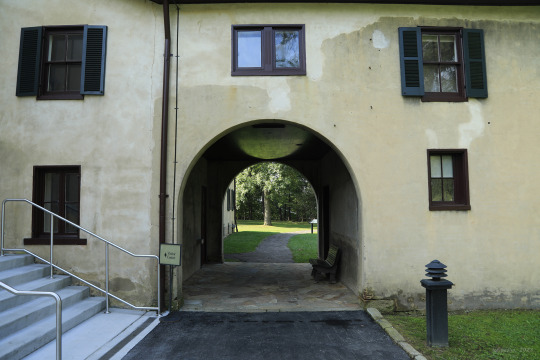
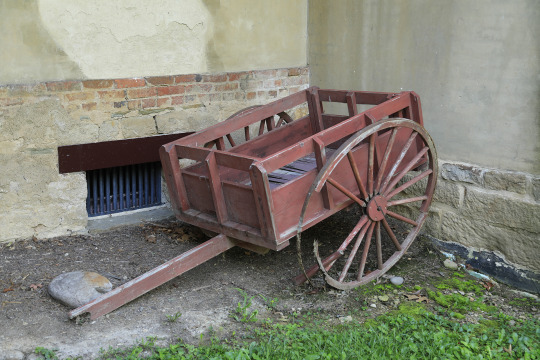


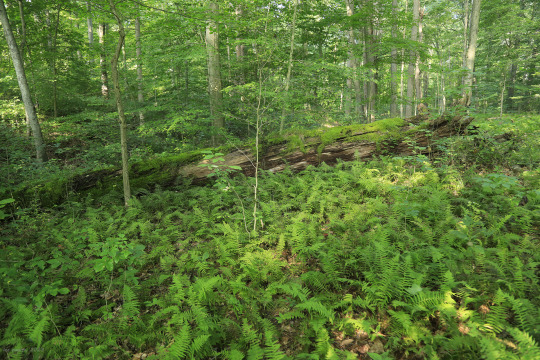



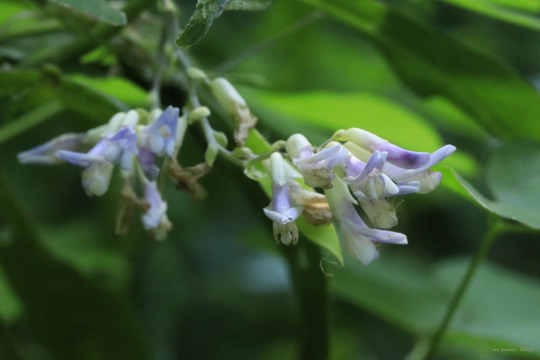

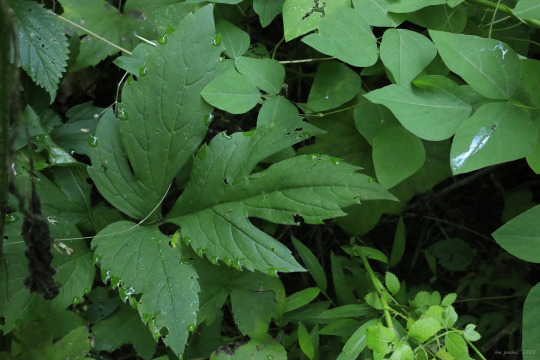
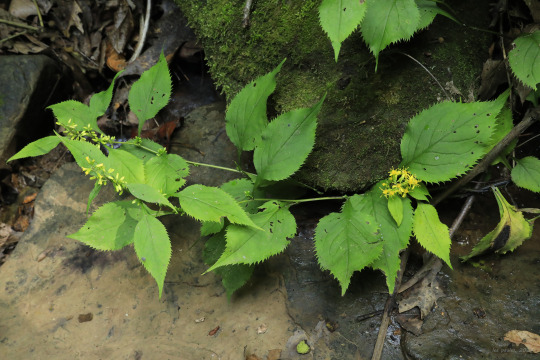
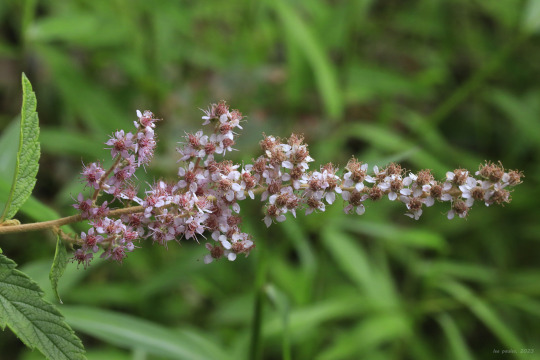
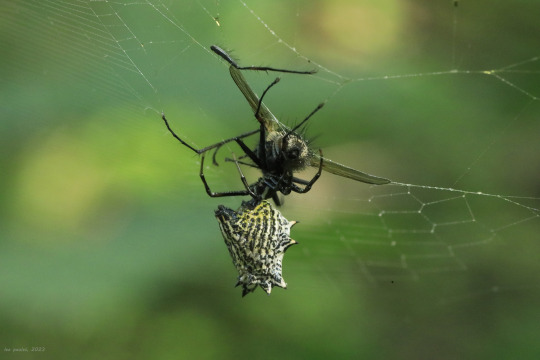

A few photos above from an early morning hike at the Friendship Hill National Historic Site near Pt. Marion, Pennsylvania. If you want to learn more about the history of this sprawling estate, you can go to this link or search for prior posts from the main search page of my Tumblr blog. In addition to the historic homestead of Albert Gallatin, the park features ten miles of hiking trails through verdant oak-hickory and riparian forests. This time of year, the Central Appalachian forest is rich with fungi, legumes, berries, and the loveliest orb-weavers imaginable.
From top: wingstem (Verbesina alternifolia), also known as yellow ironweed, a late summer aster so named because the petioles of its leaves run down the plant's stem; northern spicebush (Lindera benzoin), a gorgeous native shrub whose bright red berries in late summer are followed by the most extraordinary gold foliage in the fall; orange mycena (Mycena leaiana), a lovely, gregarious fungi of deciduous logs whose pigment has shown antibacterial and anti-cancer properties; the ripened but dangerously toxic berries of pokeweed (Phytolacca americana), whose young leaves are used by mountain folk to make poke sallet (but only after repeated cleansings to remove the toxins); American hog-peanut (Amphicarpaea bracteata), a lovely twining vine whose roots and ground nut are edible; cutleaf coneflower (Rudbeckia laciniata), also known as green-headed coneflower and wild goldenglow, a close relative of black-eyed Susan with gorgeous, pinnately-dissected leaves (the leaf photo also shows the characteristic tri-foliate leaf pattern of hog-peanut); zig-zag goldenrod (Solidago flexicaulis), one of two adorable woodland goldenrods that grow in this area (the other being blue-stemmed goldenrod), both of which produce clusters of brilliant yellow flowers in both their leaf axils and at the ends of their stems; steeplebush (Spiraea tomentosa), also known as hardhack, which produces delicate plumes of pink flowers in late summer; a spined micrathena (Micrathena gracilis), which has ensnared a fly in her web; and an arrowhead orb weaver (Verrucosa arenata), also known as a triangle orb-weaver, a sparkling gem of an arachnid that reels in its prey like a fisherman dragging in a net.
#appalachia#vandalia#wildflowers#flora#summer#arachnid#pennsylvania#friendship hill national historic site#fungi#orange mycena#wingstem#yellow ironweed#northern spicebush#pokeweed#american hog-peanut#cutleaf coneflower#green-headed coneflower#wild goldenglow#zig-zag goldenrod#steeplebush#hardhack#orb-weaver#spider#spined micrathena#arrowhead orb-weaver#triangle orb-weaver
23 notes
·
View notes
Text
Illinois
PAbingdon
• Big Daddy Totem Pole
Addison
• Nike Park
Aledo
Altamont
• On the Rox Pub and Grub
Alto Pass
• Bald Knob Cross of Peace
Alton
• Alton Military Prison, National Register of Historic Places
• Alton Museum of History & Art, Inc.
• Lincoln/Douglas Square
• Miles Davis statue
• Piasa Bird
• Robert Wadlow Statue
• The Soul Asylum
Arcola
• Arcola chamber of commerce
• A Walk Through Time, featuring Raggedy Ann and Andy
• Hippie Memorial
• Illinois Central Railroad Depot
• Johnny Gruelle Monument, creator of Raggedy Ann and Andy
Aroma Park
Ashmore
Atlanta
• American Giants Museum
• Atlanta's Bunyon Giant
• J. H. Hawes Grain Elevator Historic Site
• Mattingly Automotive
• Smiley Face
Auborn
• Illinois Brick Road
Aurora
• Aurora University
• Bedrosian Plaza
• City of Aurora- Phillips Park Zoo
• Dunham Hall,
• Grand Dental - Aurora
• Hollywood Casino Aurora
• Philips Park Zoo
• Swimming Stones Sculpture
Barrington
• Langendorf Park
Batavia
• Batavia Depot Museum
• Depot Pond
• Fabyan Forest Preserve
• Fabyan Windmill
• Fermilab
Lemont
• Argonne National Laboratory
• Argonne Research Library
Batchtown
Belleville
• National Shrine of Our Lady of the Snows
Belvidere
• Boone County museum of History
• Highland Garden of Memories
Benton
• Benton, George Harrison Mural
• Benton IL, Historic Jail Museum
• Franklin County Garage Museum
• Louise Harrison-Caldwell House - Beatles Historic Site
Benville
Berwyn
• Cigars and Stripes BBQ Lounge
• Paisans Pizzeria
• Worlds Largest Laundromat
Bloomington
• Bloomington Center for the Performing Arts
• Central Illinois Regional Airport at Bloomington-Normal
• Embark Tree Removal
• Evergreen Memorial Cemetery
• McLean County Museum of History
• McPherson Theatre
• Miller Park
• Miller Park War Memorial
• Miller Park Zoo
• Nord Animal Hospital
• Prairie Aviation Museum
• Steel And Bedrock House
Blue Island
Bourbonnais
* Childrens Memorial Park
* Exploration Park
Braidwood
Braidwood Zoo
Polk-A-Dot Drive In
Breese
Broadwell
• Pig Hip restaurant Memorial
Brookfield
• Brookfield family restaurant
• Brookfield Zoo
Brownstown
Brussels
• Brussels Village Jail
Buncombe
Bunker Hill
• Lincoln statue Bunker Hill
Burbank
• Haunted Trails Family Entertainment Center (Burbank)
Burr Ridge
• Burr Ridge Veterans Memorial
Cahokia
• Greater St. Louis Air and Space Museum
Cairo
• Fort Defiance State Park
Calumet City
• Calumet City Yellow Smiley Face Water Tower
Cambridge
• Rosedale Cemetery
Carbondale
• Jeremy "Boo" Rochman Memorial Park
• R. Buckminster Fuller and Anne Hewlett Dome Home
• Saluki Stadium
• Southern Illinois University
Carmi
• Little Giant Grocery
Carol Stream
• Augustino's Rock and Roll Deli and Grill
Carthage
• Kibbe Hancock Heritage Museum
Casey
• Big Bookworm
• Big Cactus
• Big Nail Puzzle
• Big Pencil
• Big Yardstick
• Casey Country Club
• Cilantros Grill & Cantina
• JJET Rental Sales & Service
• Largest Bird Cage
• Wildflour Bakery & Candy Co
• World's Largest Pitchfork
• Worlds Largest Golf Tee
• World's Largest Key
• World's Largest Knitting Needles and Crochet Hook
• World's Largest Mailbox
• World's Largest Rocking Chair
• World's Largest Swizzle Spoon
• World's Largest Teeter Toter
• World's Largest Wind Chime
• World's Largest Wooden Shoes
Cave-In-Rock
• Cave-in-Rock State Park
Centralia
• Centralia Carillon
• Centralia Area Historical Museum
Champaign
• Curtis Orchard & Pumpkin Patch
• Kraft
• Virginia Theatre
Charleston
• Grace the Shark
• Morton Park
Chatsworth
Chenoa
Cherry
• Cherry Miner's Cemetery
Chester
• Reids' Harvest House
• Spinach Can Collectibles
• Statue of Alice the Goon
• Statue of Bluto
• Statue of Castor Oyl and Bernice the Whiffle Hen
• Statue of Cole Oyl
• Statue of Olive Oyl/Swee'Pea/Jeep
• Statue of Popeye
• Statue of Sea Hag and Bernard the Vulture
• Statue of Stinger the Yellow Jacket
• Statue of Wimpy
Chesterville
• Chesterville Cemetery
Chestnut
Cicero
• Henry's Drive-In
Collinsville
• Worlds Largest Catsup Bottle
Cornell
• Friendship Shoe Fence
Covell
• Charles Lindbergh Crash Site #2
Crestwood
• Nike Missile Site C-44
Crystal Lake
• The Greenhouse of Crystal Lake
Cullom
Danville
• Danville Area Visitors Bureau
• Lindley Sign Post Forest
• Temple Plaza
Darien
• National Shrine of St. Therese
DeKalb
• Ellwood House Museum
• Northern Illinois University
Decatur
• Chevrolet Hall of Fame Museum
• Wild Dog Saloon
Des Plaines
• Golf Center Des Plaines
• The Choo Choo
• Square Deal Shoe Store
Diamond
• Diamond Mine Disaster Monument
Dixon
• John Deere Historic Site
• Lowell Park
• Ronald Reagan Boyhood Home
• Veterans Memorial Park
• Wings of Peace and Freedom Park
Downers Grove
Durand
• A. C. McCartney Equipment
Dwight
• Amblers Texaco Gas Station
• Cardiff Town State Historic Site
East Moline
• John Deere Harvester Works
East Peoria
• Carl's Bakery & Restaurant
• Last Harvest Ministries
• Twistee Treat
Edwardsville
• Buckminster Fuller Dome
• Center for Spirituality and Sustainability
• Madison County Historical Museum
• Southern Illinois University Edwardsville
Effingham
• The Cross at the Crossroads
• Merz Heating & Air Conditioning
• Mid America Motorworks
• My Garage Museum and Store
Elburn
• Larsons Light Show
Eldorado
• Big John's
Eldred
Elizabeth
• Cajun Jack's Bar & Grill
Elk Grove Village
• Busse Woods
• Ned Brown Meadow
Ellsworth
• Twin Groves Wind Farm
Elmwood Park
• World’s Largest Radio Flyer Wagon
Elsworth
• Ellsworth water tower/Baseball
Elwood
• Midewin Iron Bridge Trailhead
Dawson Township
• Ellsworth water tower/Baseball
Eureka
• Eureka College
• Ronald Reagan Museum
• Section of the Berlin Wall
Evanston
• American Toby Jug Museum
Findlay
• Goat Tower Farm
Forest Park
• Little Teeth Big Smiles Children's Dentistry
• Woodlawn Funeral Home & Memorial Park
Forrest
Jerry’s Hat Museum
Wabash Railroad Model Train Museum
Jackson Township
• Midewin Iron Bridge Trailhead
Leyden Township
• World’s Largest Radio Flyer Wagon
Windsor
• Goat Tower Farm
0 notes
Photo
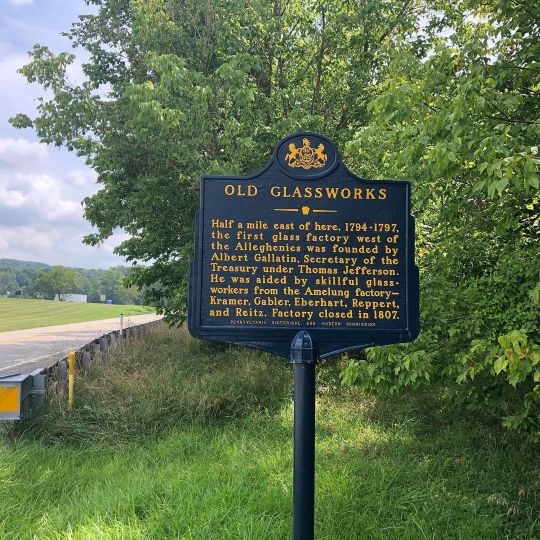
at Friendship Hill National Historic Site https://www.instagram.com/p/CRxRBcBsjXi/?utm_medium=tumblr
0 notes
Photo

This was a fun yet spooky hike. #friendshiphill #nationalpark #hiking #getoutside #vanlife #travel #solotravel (at Friendship Hill National Historic Site) https://www.instagram.com/p/CTa8eojLMV4/?utm_medium=tumblr
1 note
·
View note
Text
Some Famous Landmarks of America to Peak on Your Vacation
The United States of America is known for the world’s most dominant economic and military power. Besides, it is worldwide popular for tourist destinations also. Every year, millions of tourists are attracted to visit some famous landmarks of America. Among them these 10 landmarks are considered to be the most important part of America’s tourism.
1. The Hollywood Sign, Los Angeles
Debuting in 1923, the Hollywood Sign has become a Los Angeles icon and synonymous with the city. The sign debuted as an advertisement for the upscale Hollywood housing development but sooner it became an icon which has been imitated the world over. You’ll be amazed to know that originally it was built as “HOLLYWOODLAND” for a real estate development but the sign was rebuilt as “HOLLYWOOD” in 1949. Though you are not allowed to touch or visit the sign closely but still the sight will touch your mind and you’ll feel the magic.
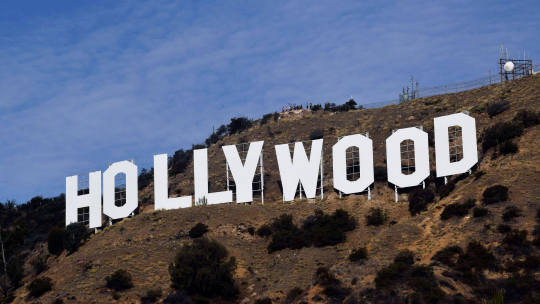
2. Mount Rushmore, South Dakota
The shrine of America’s democracy, Mount Rushmore is a massive sculpture carved into the Black Hills region of South Dakota. Featuring the 60-foot faces of America’s four greatest presidents who represents the birth, growth, development and preservation of the country. Three million tourists every year visit Mount Rushmore to experience this patriotic location. Do visit the site with friends and families to enrich your historical knowledge.
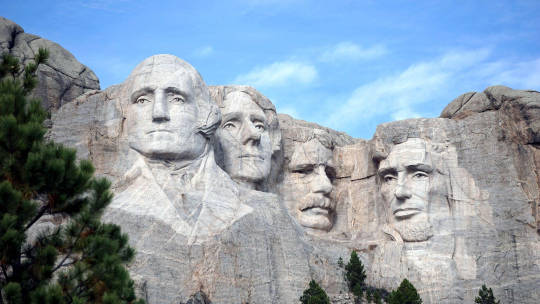
3. Statue of Liberty, New York
Located on Liberty Island just off Lower Manhattan on the mainland of New York City, the symbol of freedom and one of the most recognized figures of the United States. It is the Statue of Liberty. The most famous landmark of America. The Statue of Liberty was entitled by Frederic Auguste Bartholdi and Alexandre Gustave Eiffel and was gifted to the American people by the French as a token of the friendship formed throughout the American Revolution. In 1984, UNESCO signified it as a World Heritage Site. Their “Statement of Significance” describes it as a “masterpiece of the human spirit”. A visit to the Liberty Island can help you meet the symbol of ideals such as liberty, peace, human rights, abolition of slavery, democracy and opportunity. And obviously a picture with the statue will enlighten your facebook wall & insta stories.

4. Grand Canyon, Arizona
If you’re a traveler then Grand Canyon must be in your bucket list. According to Theodore Roosevelt it is one of the greatest sights which every American should see. A surprising fact is that in 2017 alone, more than 6.25 million people visited the Grand Canyon. Biking, hiking, boating what you can’t enjoy at the place? If a summer trip is your only option, or you want to avoid the crowds, head to the North Rim, which gets about a tenth of the visitors and it is nearly ten degrees cooler than the South Rim. But if hiking is not your cup of tea, you can either rent a bicycle or take a scenic drive through the park.
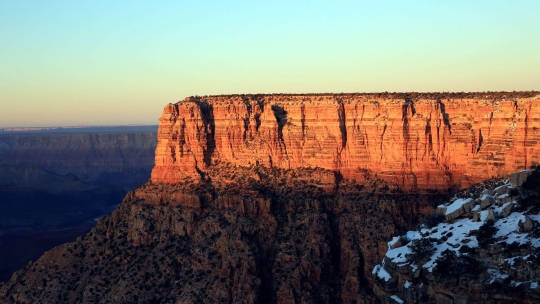
5. Golden Gate Bridge, San Francisco
The icon of San Francisco, The Golden Gate Bridge is the most popular and gorgeous tourist attraction. It’s gently curved cables and deep orange hue are a total showstopper. Specially, cycling on the bridge will stand out as a breathtaking experience for the cycle lovers. Wonderful sunlight, the great bridges, the Pacific at your shoes; maybe that’s why Dylan Thomas once wrote, “You wouldn’t think such a place as San Francisco could exist. The Cavallo Point, Cruise of San Francisco Bay, Golden Gate Recreational Area and the bridge; you’ll be delighted with the all in one package.
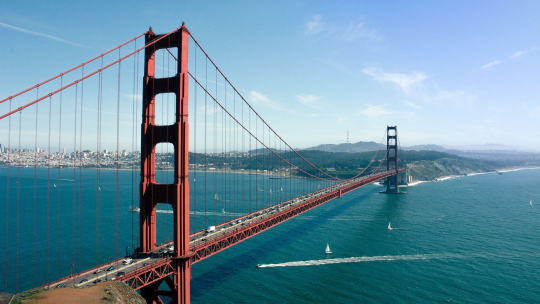
6. Lincoln Memorial, Washington
With an average of 6 million visitors every year, Lincoln Memorial is a must visit while in Washington, DC. The Lincoln Memorial showcases an fascinating architecture of an ancient Greek Doric Temple; it was built using the Yule Marble inserted from Colorado. Though it is always open for visitors but early morning and late evening is the most precious time to enjoy its beauty.
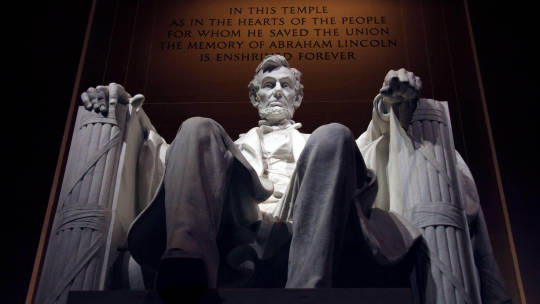
7. Hoover Dam, Nevada
The Hoover Dam is located on the Arizona-Nevada border on Highway 93. It is a popular tourist destination whose Bureau of Reclamation tour alone draws nearly 1 million visitors every year. You can drive across the Dam and stop to enjoy the tempting view with some memorable photographs. But remember! Don’t stop your car in the streets. You can park at The visitors center which is on the Nevada side of the dam. It can be a bit more crowded but is a good place to park. The Colorado River below Hoover Dam is packed with geothermal countenance, including sauna caves, hot waterfalls and multilevel hot pools. Renting a houseboat on either lake and glide through water-filled canyons can make your trip more adventurous.

8. Yosemite National Park, California
In California’s Sierra Nevada mountains, Yosemite National Park has been a long place of inspiration for artists, climbers, and nature lovers. Hiking, biking, and climbing, visiting museums and galleries, you can find things to do all over the park. Yosemite Falls is the most memorable and striking feature of it. You can walk right to the base of the falls with minimal effort and feel the mist wide spreading over you. Also, if you’re induced to rock climbing then El Capitan will be warmly welcoming you. It is a breathtaking representation of Yosemite’s natural beauty. Don’t worry, there’s more. If hiking is your cup of tea then you must visit the Vernal Fall. It is one of the most popular hiking routes in all of Yosemite. The Mist Trails can be slippery from the mist during the spring and early summer so don’t forget to watch your steps.
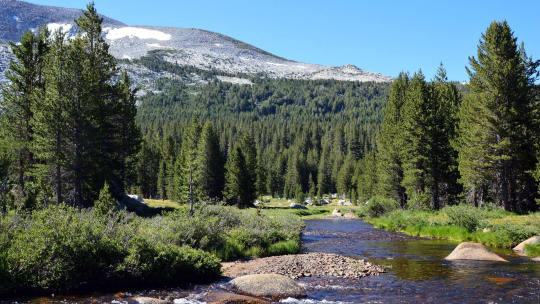
9. Monticello, Charlottesville
Monticello is located in Arkansas’ southeast region near Mississippi and Louisiana. It is the county seat of Drew County. The city has a constant population that hasn’t changed much in decades, hovering just below the 10,000 residents mark. Thomas Jefferson, the founding father and third US president designed and inhabited the house at Monticello. He spent 40 years building his dream home. The Drew County Historical Museum is located on South Main Street in Monticello. It is the town’s most complete repository of historical artefacts, antiques and exhibits that relate to the culture and history of the area that was explored and settled more than 150 years ago. If you’re travelling with a large group then consider calling ahead to schedule a tour. Also, don’t miss to visit the Lake Monticello, Pomeroy Planetarium & UAM Fine Arts Galleries to add some extra spice to your tour is an architectural masterpiece.
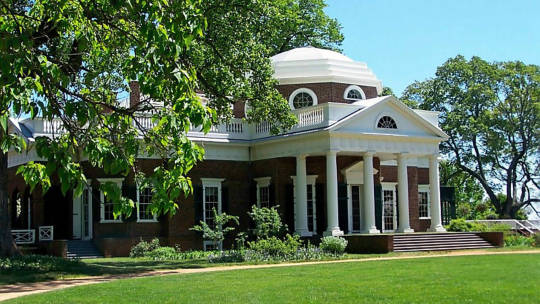
10. The Bean, Chicago
You might have seen The Bean in any of the movie scenes. It is a work of public art in the heart of Chicago. The sculpture, which is officially titled Cloud Gate, is one of the world’s largest inverted outdoor art installations. Inspired by liquid mercury, The Bean was made with a reflective surface. This shiny exotic reflects its surroundings. The people in the park, the lights of Michigan Avenue, and the surrounding skyline and green space. The polished surface invites the visitors to touch and observe their own reflection, involving it as an interactive creation. The exterior of The Bean is made entirely of stainless steel. Computer technology was used to precisely cut 168 massive steel plates, which were then shaped together and welded shut for a completely seamless finish.
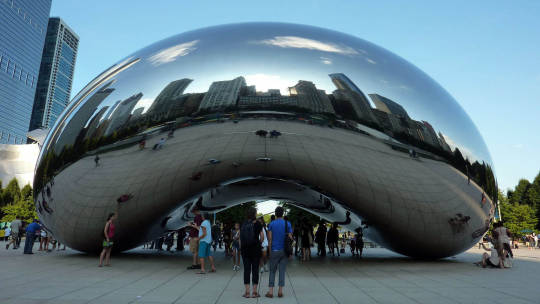
Choice is upon individuals but among these, I personally like the Hoover Dam & Yosemite National Park. The tempting view of nature with spectacular photographic locations melt me up. Once the COVID – 19 restrictions are lifted I would surely love to go on hiking there.
0 notes